視知覚の現象・機能・メカニズム ― 生理学的、心理物理学的、計算論的アプローチ
自然科学研究機構岡崎コンファレンスセンター中会議室(愛知県岡崎市)
2013年9月12日(木)16:20-16:55
色依存性の静止画が動いて見える錯視
The color-dependent motion illusion in static images
Akiyoshi Kitaoka, Ritsumeikan University / JST CREST
since September 10, 2013 Handout 1 2
Warning: This page includes real animations. Please do not keep watching them for a long time. Although this page has carefully avoided the known harmful stimuli, unknown ones might happen to be included. Never copy them.
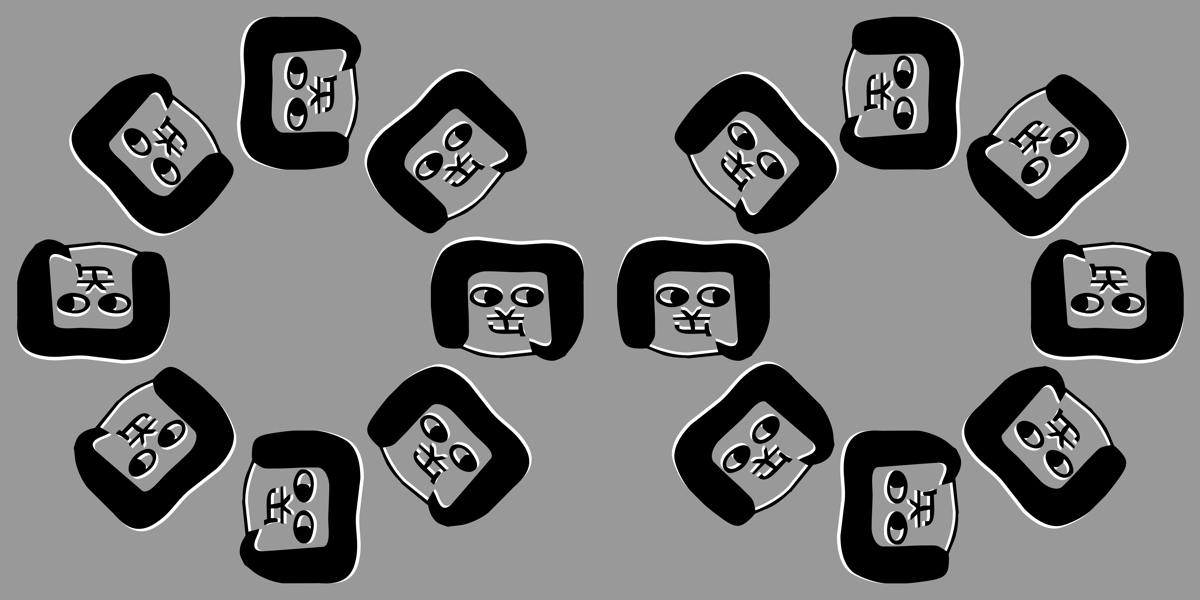
「オカザえもんの回転」
右のリングは時計回りに、左のリングは半時計回りに回転して見える。
Produced by Akiyoshi Kitaoka 2013 (September 9)
オカザえもんは許諾を得て使用
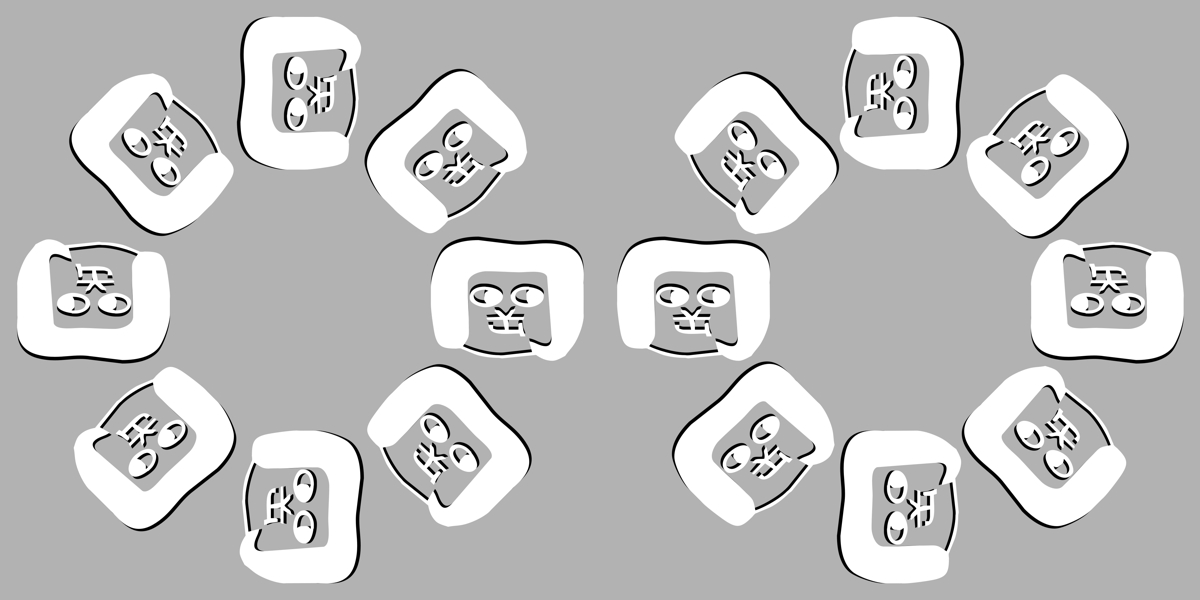
「白いオカザえもんの回転」
Produced by Akiyoshi Kitaoka 2013 (September 10)
オカザえもんは許諾を得て使用
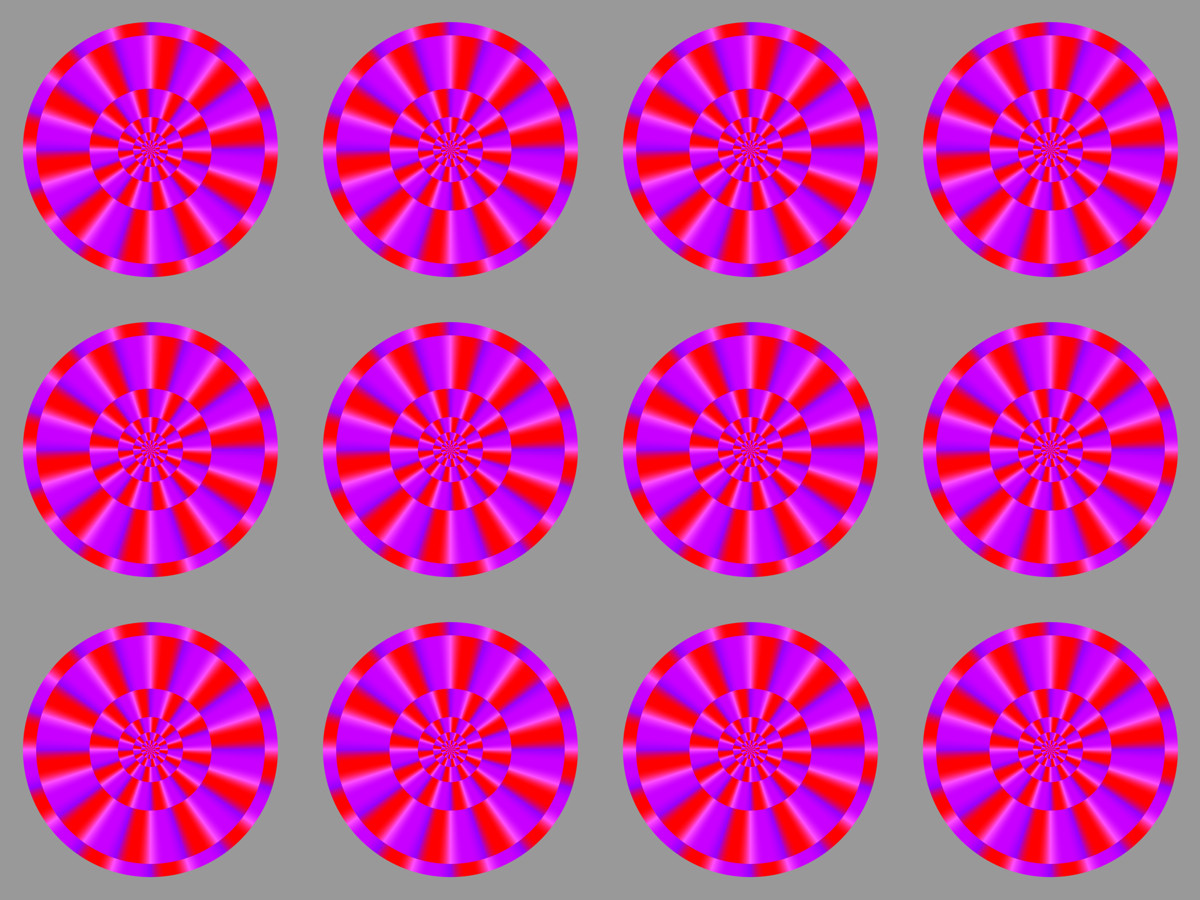
"Rotating red-and-purple disks"
Each disk appears to rotate clockwise on a bright display, while it appears to rotate counterclockwise with a printed image under dark illumination.
Copyright Akiyoshi Kitaoka 2013 (February 6)
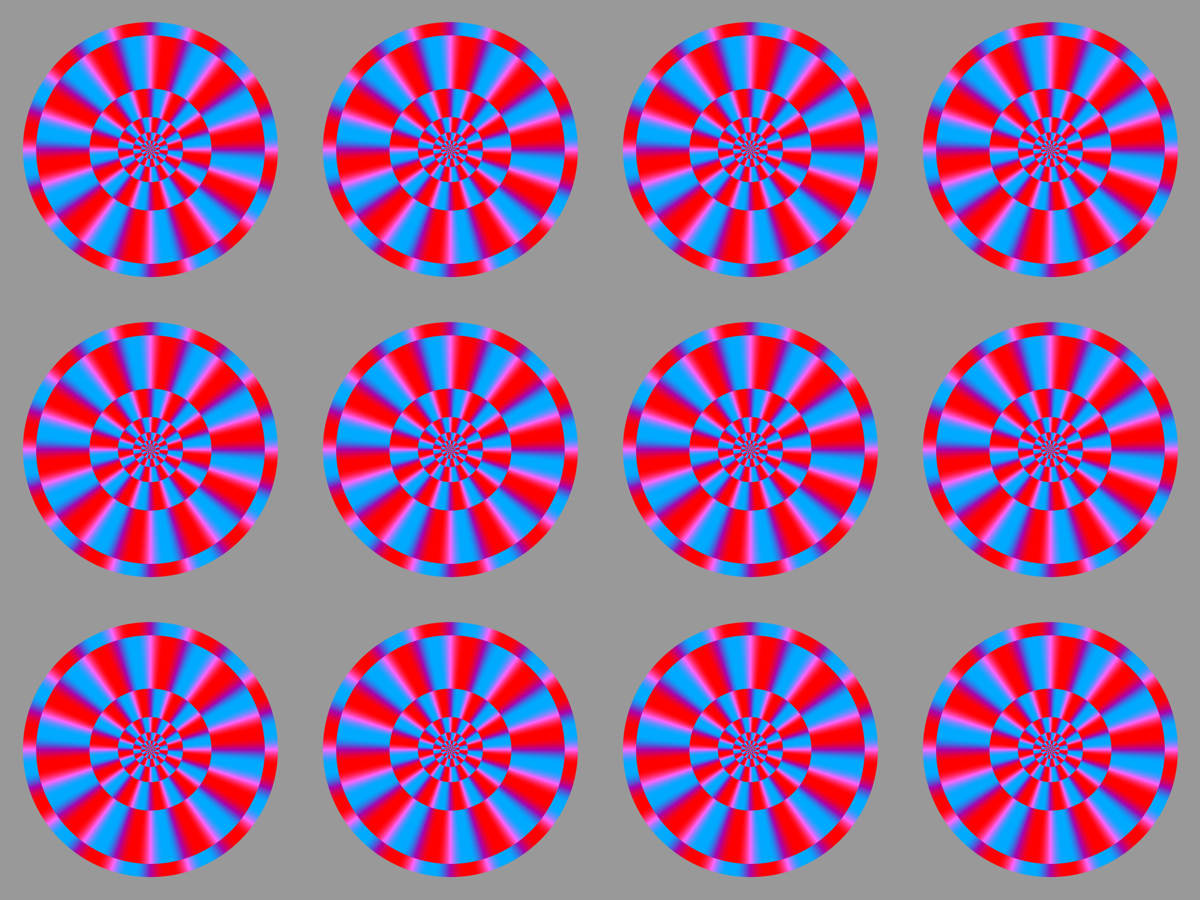
"Rotating red-and-cyan disks 2"
Each disk appears to rotate clockwise on a bright display, while it appears to rotate counterclockwise with a printed image under dark illumination.
Copyright Akiyoshi Kitaoka 2013 (February 6)
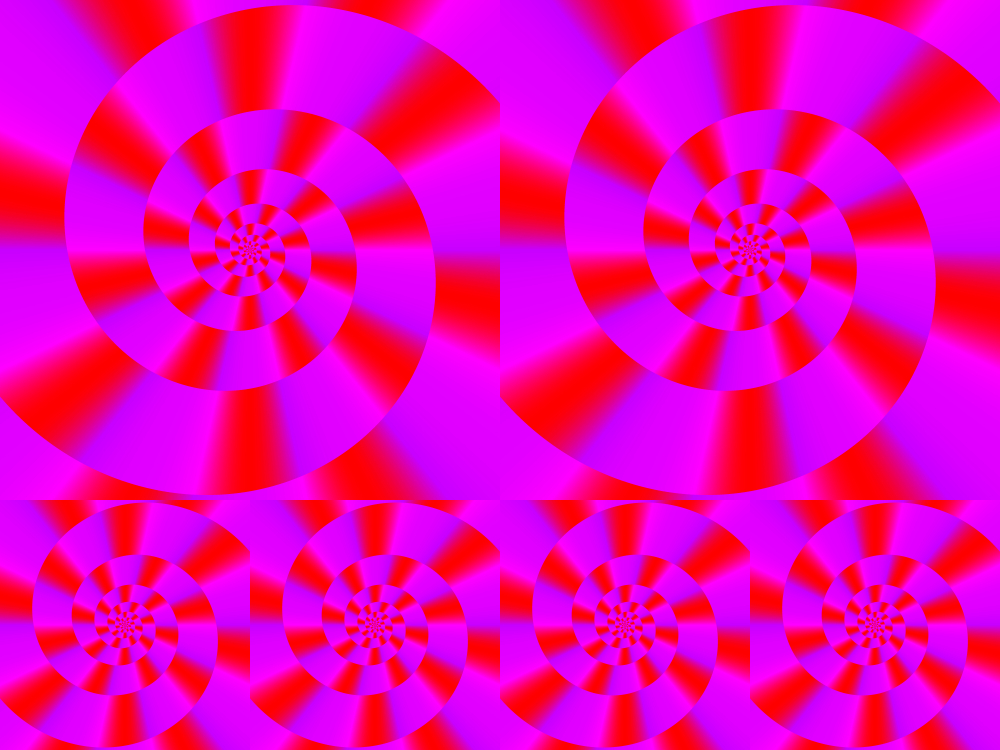
"Takonyudo"
takonyudo = octopus
Each disk appears to rotate counterclockwise when this image is presented on a bright PC display or in a print with a bright environment.
Copyright Akiyoshi Kitaoka 2009 (January 11)
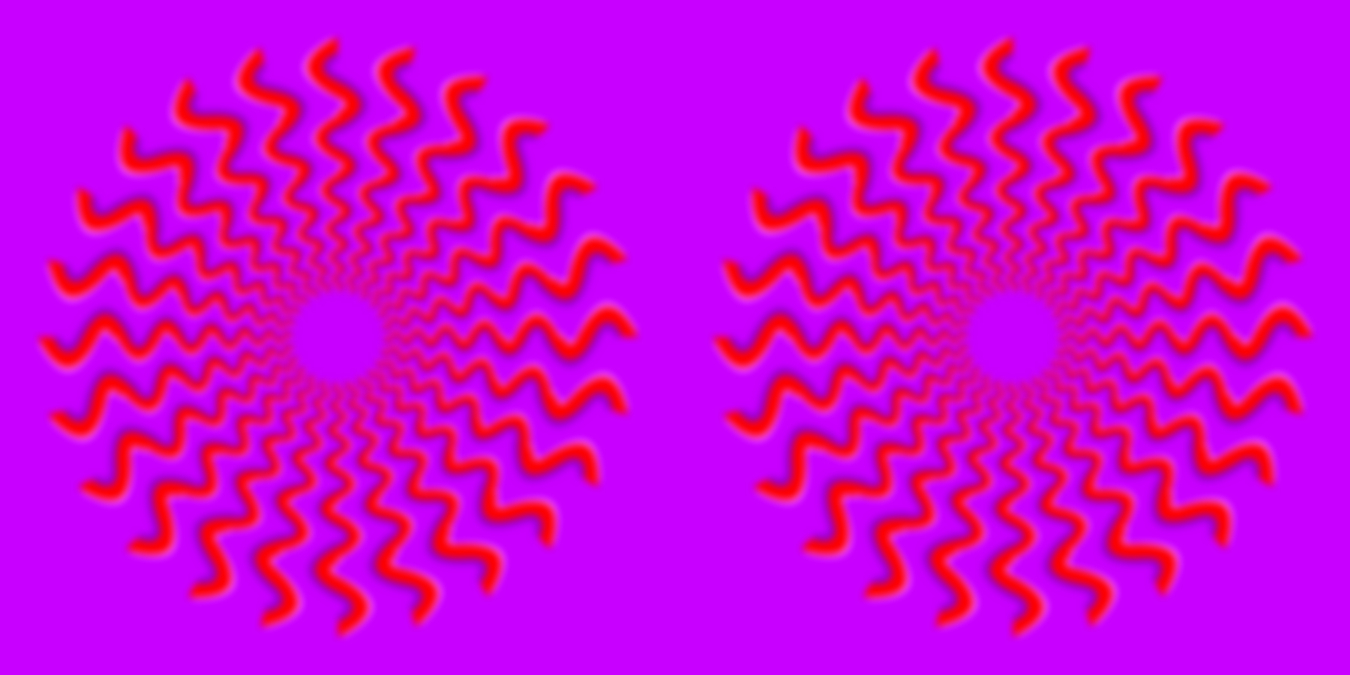
"Fudo-myo-o 2012"
Each disk appears to rotate clockwise when this image is presented on a bright PC display or in a print with a bright environment.
Copyright Akiyoshi Kitaoka 2012 (December 3)
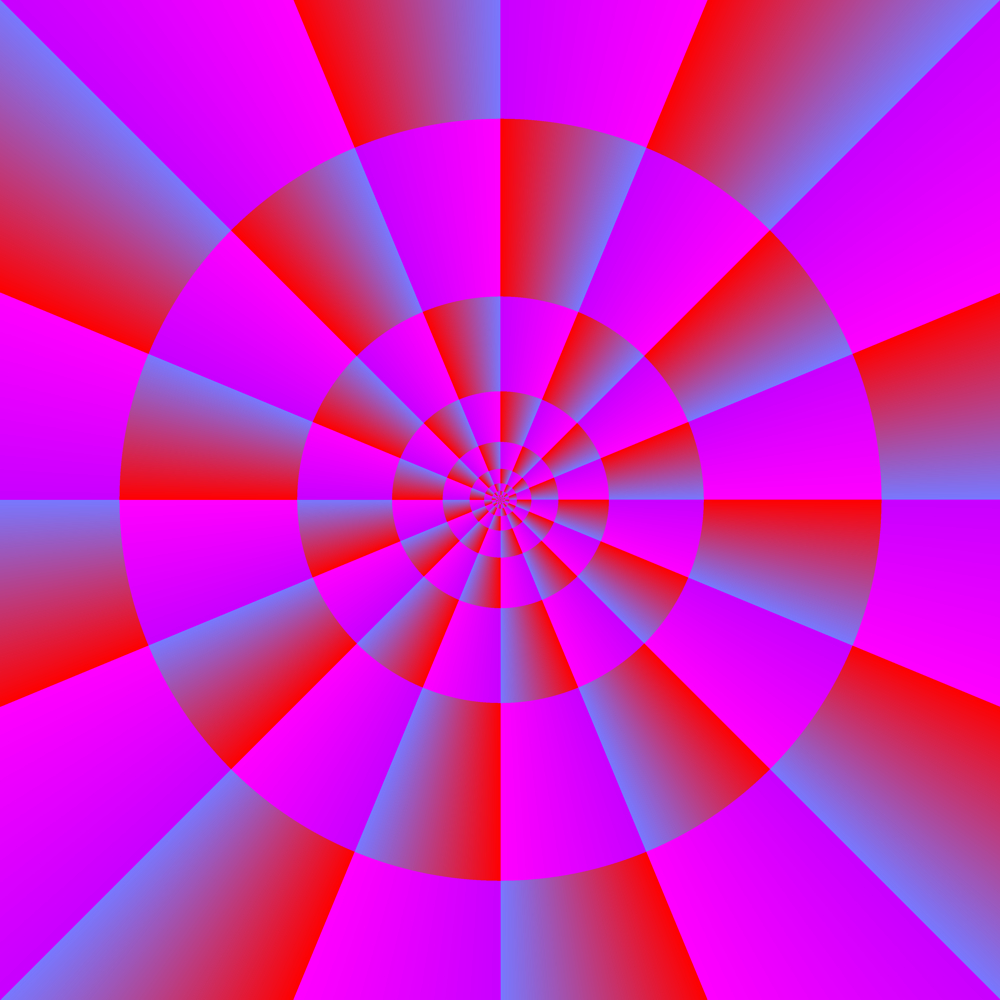
The disk appears to rotate clockwise when this image is presented on a bright PC display or in a print with a bright environment.
Copyright Akiyoshi Kitaoka 2013 (June 21)
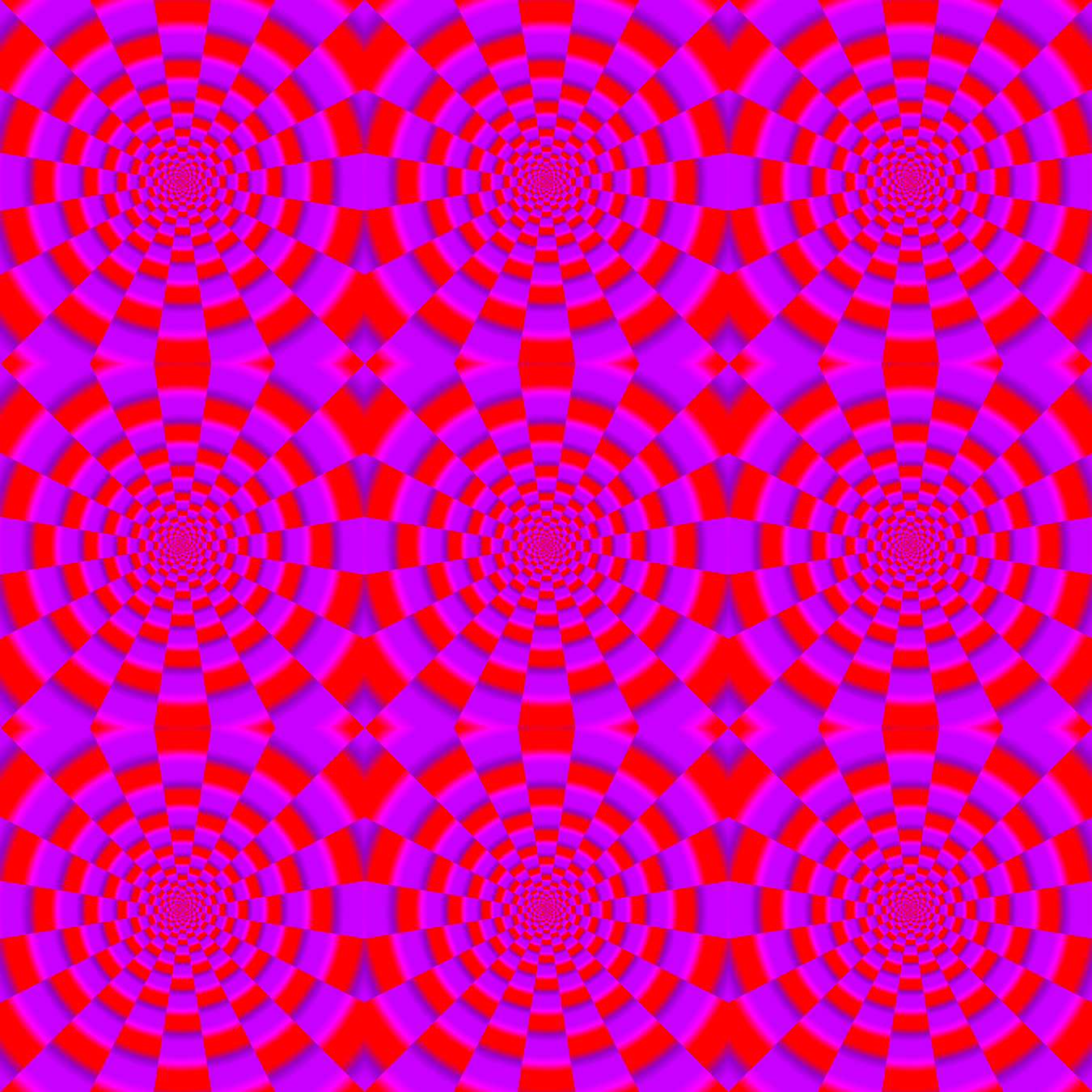
"Active volcano"
Each disk appears to expand when this image is presented on a bright PC display or in a print with a bright environment..
Copyright Akiyoshi Kitaoka 2013 (April 7)
Conclusion in advance
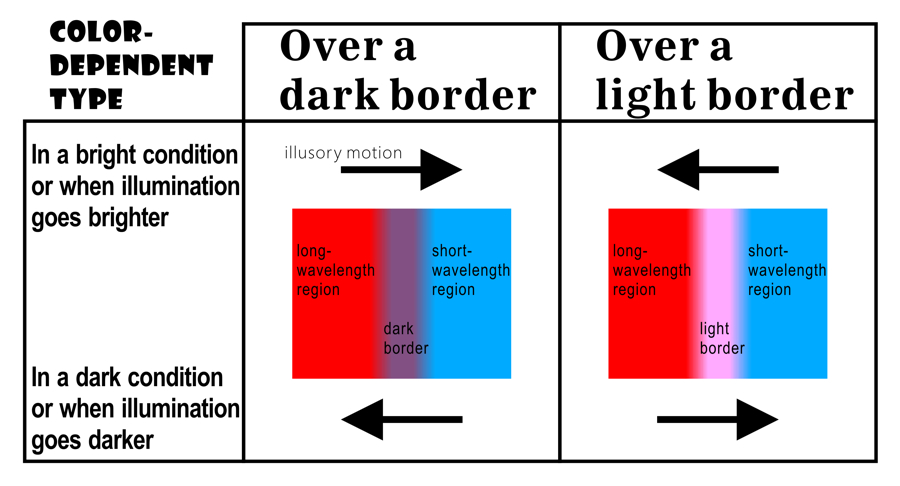
A brief history of phenomenal aspects of the Fraser-Wilcox illusion group
<Kitaoka, A. (forthcoming). The Fraser-Wilcox illusion and its extension. In Shapiro, A. and Todorovic, D. (Eds.), Oxford Compendium of Visual Illusions. Oxford University Press.>
1. Fraser and Wilcox (1979)
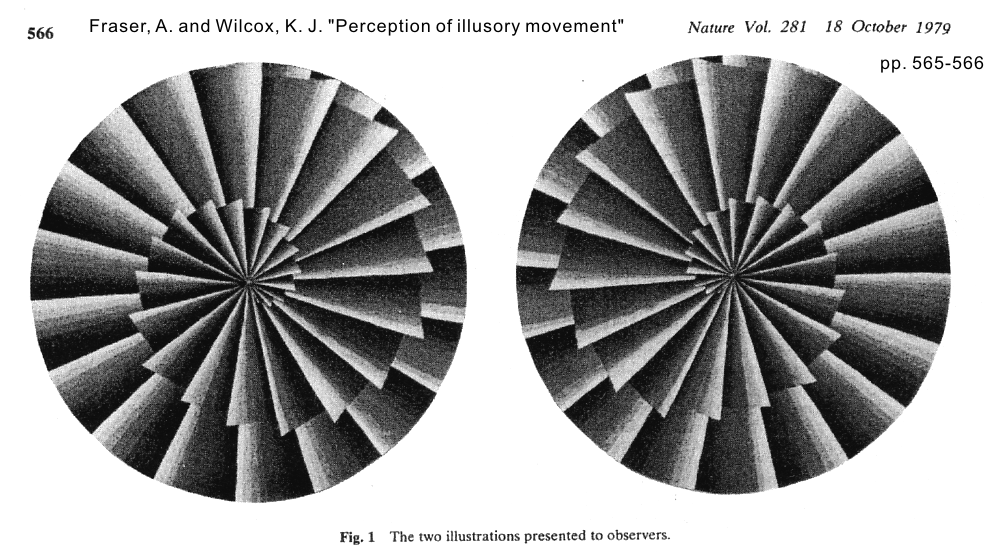
References
Fraser, A. and Wilcox, K. J. (1979). Perception of illusory movement. Nature, 281, 565-566.
Observers saw illusory motion in a stationary image which consists of repeated luminnace gradient in a saw-tooth wave form. Some reported illusory motion from dark to light along a luminance gradient, while others saw the reversal. The illusion is strong in the peripheral viewing. Fraser and Wilcox (1979) claimed that this individual difference depends on some genetic properties.
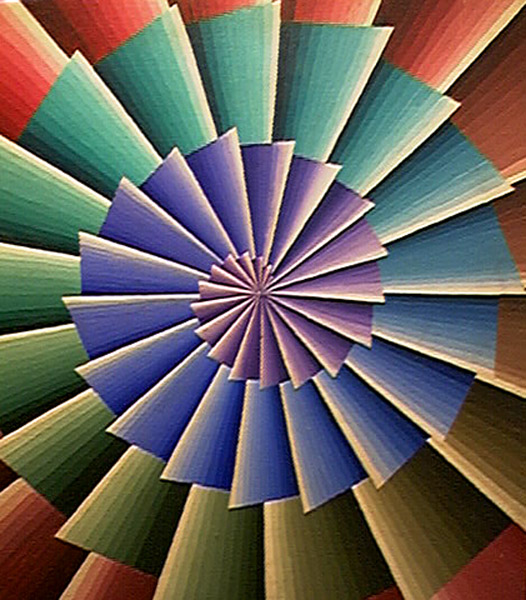
Adopted from “Alex Fraser, Geneticist and Painter”
(http://doctoralexfraser.blogspot.jp/p/spirals.html) <access August 25, 2012> (with permission from Alan Fraser)
Alex Fraser (1923-2002) was a geneticist and a painter.
2. Faubert and Herbert (1999)
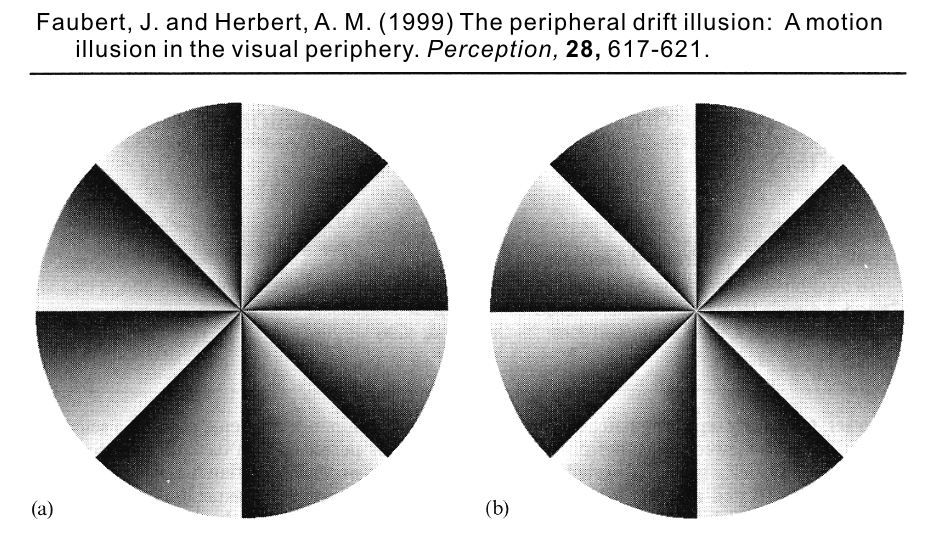
The left disk appears to rotate clockwise while the right one counterclockwise. Faubert and Herbert (1999) reported only illusory motion from dark to light along a luminance gradient. They attributed the illusory motion to the assumed time difference between responses to black and white.
References
Faubert, J. and Herbert, A. M. (1999). The peripheral drift illusion: A motion illusion in the visual periphery. Perception, 28, 617-621.
3. Naor-Raz and Sekuler (2000)
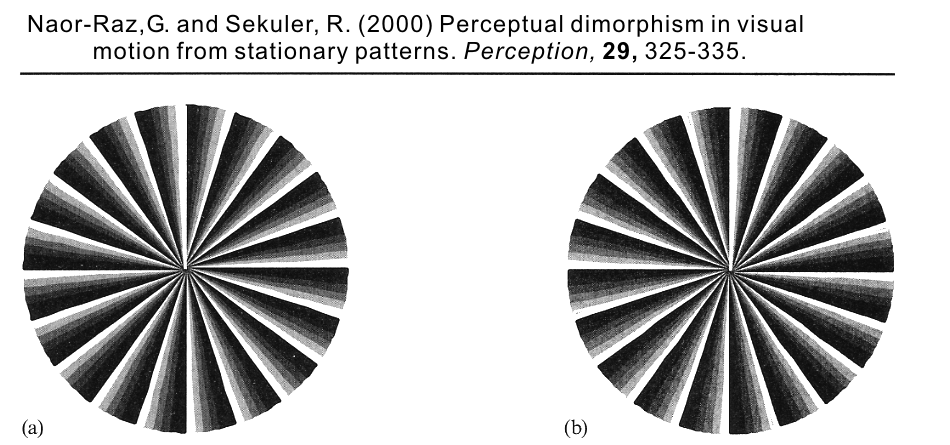
The left disk appears to rotate clockwise while the right one counterclockwise. Naor-Raz and Sekuler (2000), too, reported only illusory motion from dark to light along a luminance gradient. They revealed that the illusion magnitude is a positive, nearly linear function of contrast.
References
Naor-Raz, G. and Sekuler, R. (2000). Perceptual dimorphism in visual motion from stationary patterns. Perception, 29, 325-335.
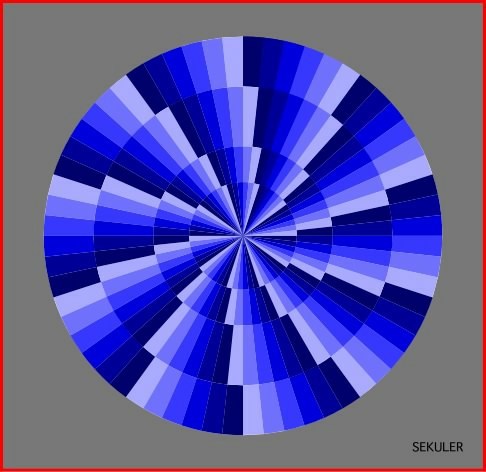
This disk appears to rotate clockwise.
This color illusion image presented by Naor-Raz and Sekuler (2000) (shown
below) might be attributable to this type.
http://www.perceptionweb.com/perception/perc0300/sekuler.jpg <access August 26, 2012>
<with permission from Robert Sekuler>
4. Kitaoka and Ashida (2003)
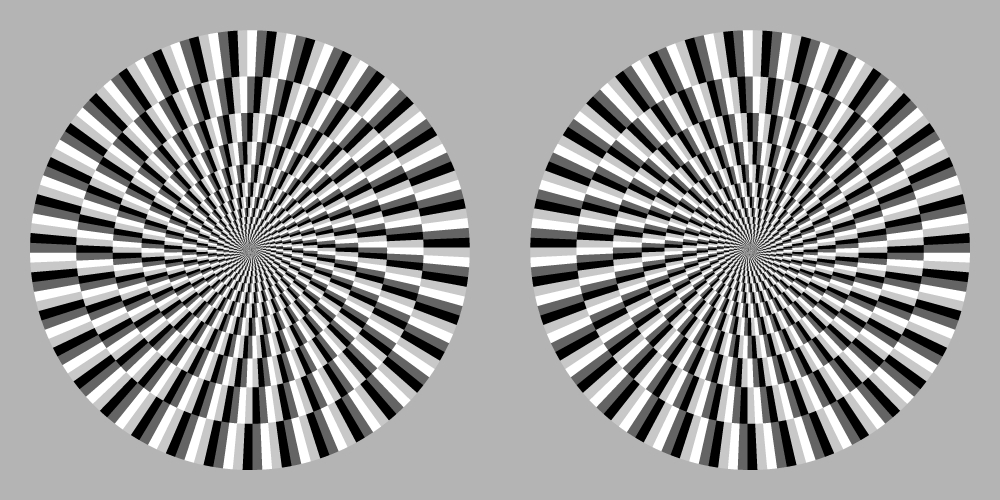
The left disk appears to rotate counterclockwise while the right one clockwise. Kitaoka and Ashida (2003) proposed that the illusory motion is strong when patterns are arranged in the following luminance order: from black, dark-gray, white, light-gray, and back to black.
References
Kitaoka, A. and Ashida, H. (2003). Phenomenal characteristics of the peripheral drift illusion. VISION (Journal of the Vision Society of Japan), 15, 261-262. PDF
5. Kitaoka (2007)
Kitaoka (2007) classified the Fraser-Wilcox illusion into Type I, IIa, IIb and III, in each of which the dark-to-light type was distinguished from the light-to-dark one.
References
Kitaoka, A. (2007) Phenomenal classification of the “optimized” Fraser-Wilcox illusion and the effect of color. Poster presentation in DemoNight, VSS2007, GWiz, Sarasota, Florida, USA, May 14, 2007.
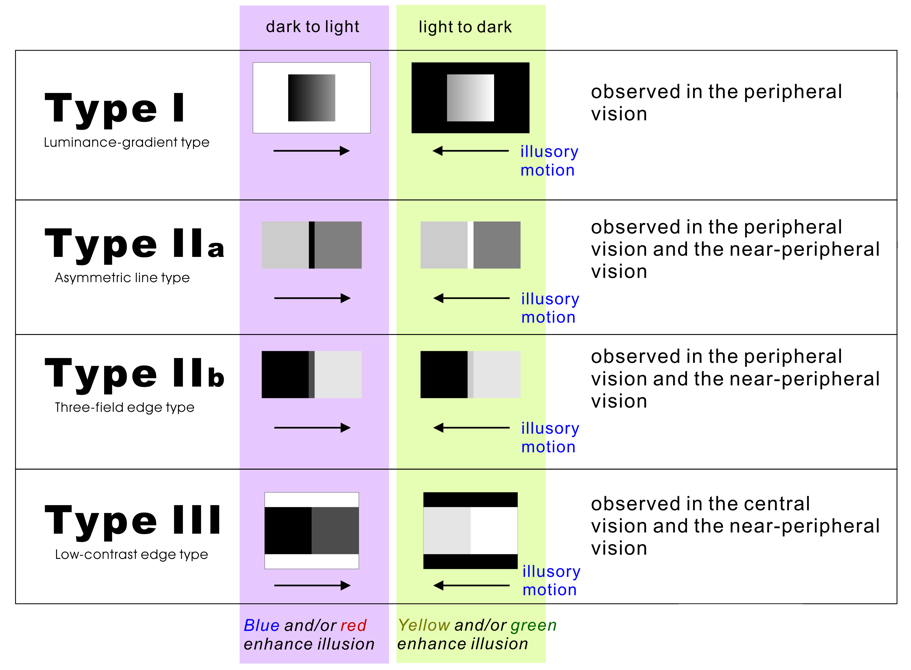
Type I
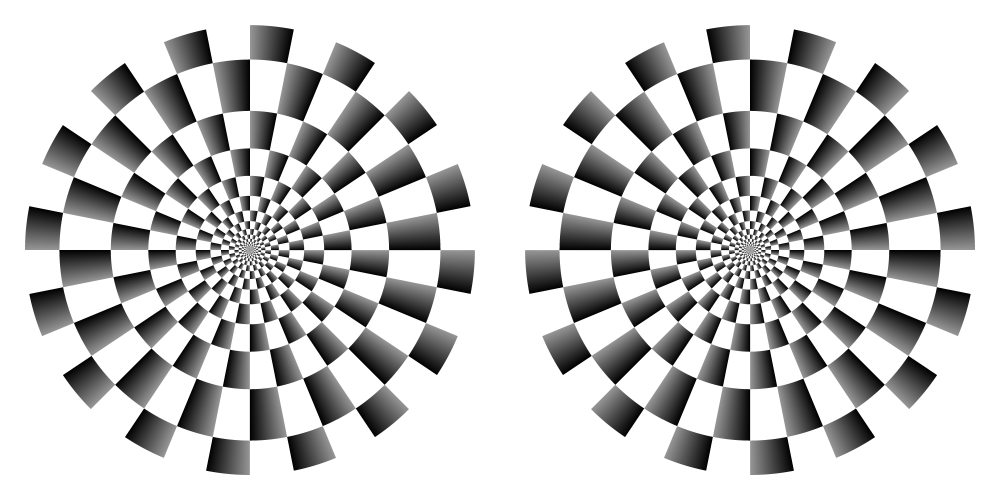
"Dark to light"
The left disk appears to rotate counterclockwise while the right one clockwise.
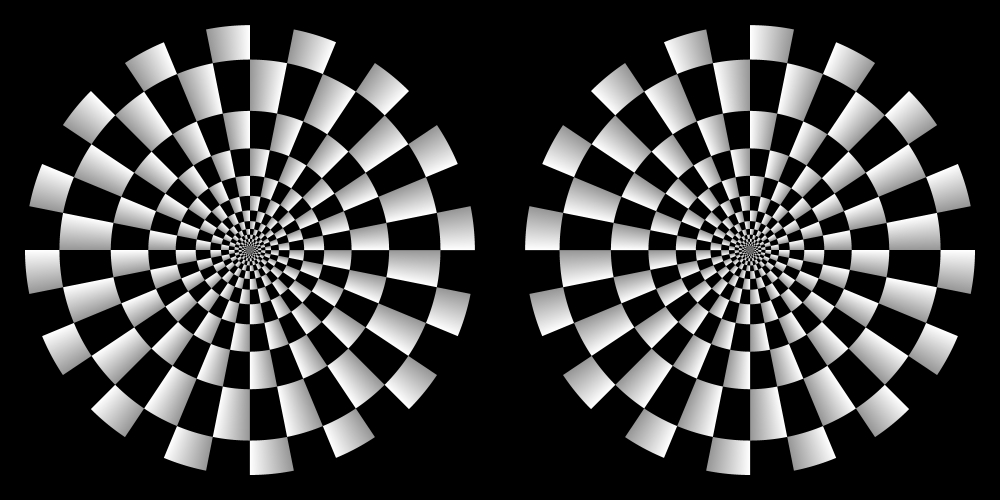
"Light to dark"
The left disk appears to rotate counterclockwise while the right one clockwise.
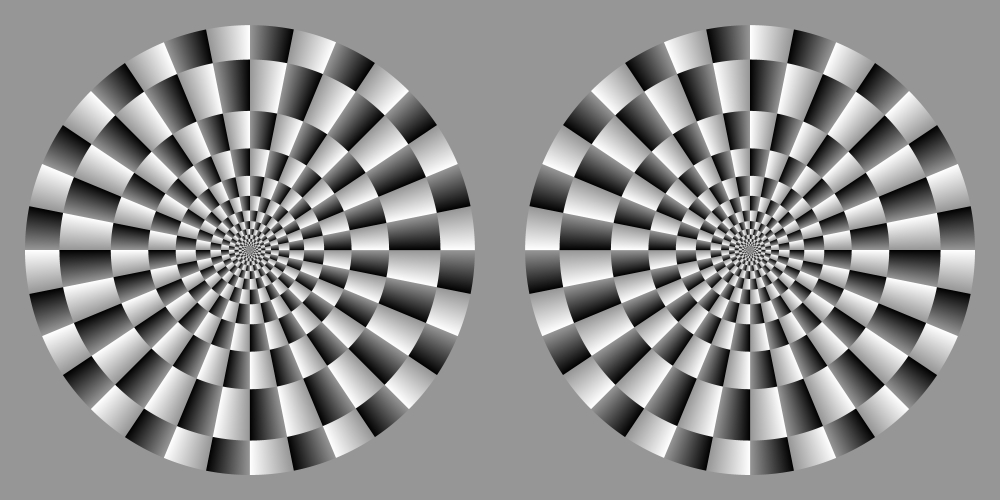
"Dark to light" and "light to dark" combined
The left disk appears to rotate counterclockwise while the right one clockwise.
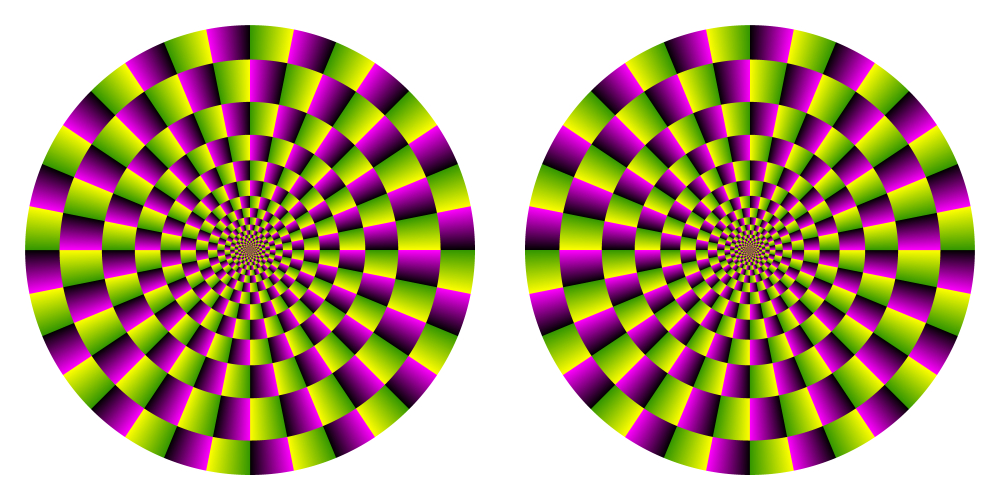
"Dark to light" and "light to dark" combined, with
color enhancement
The left disk appears to rotate counterclockwise while the right one clockwise.
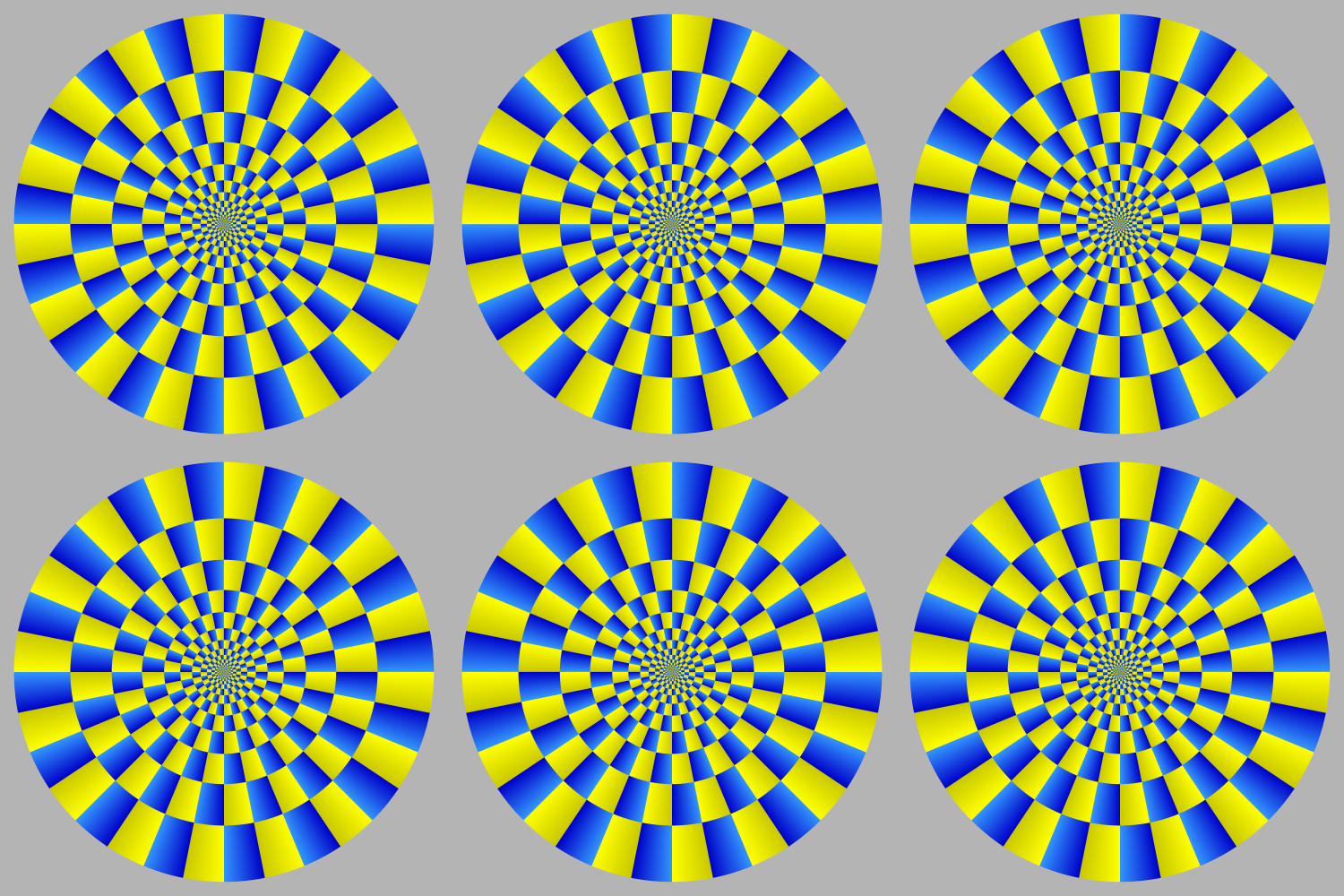
The upper-left, upper-right, and lower-middle disks appear to rotate counterclockwise
while the rest clockwise.
Type I (six disks) 1500 x 1000 (pixel)
Type I (six disks) 6000 x 4000 (pixel)
Type II
Type IIa
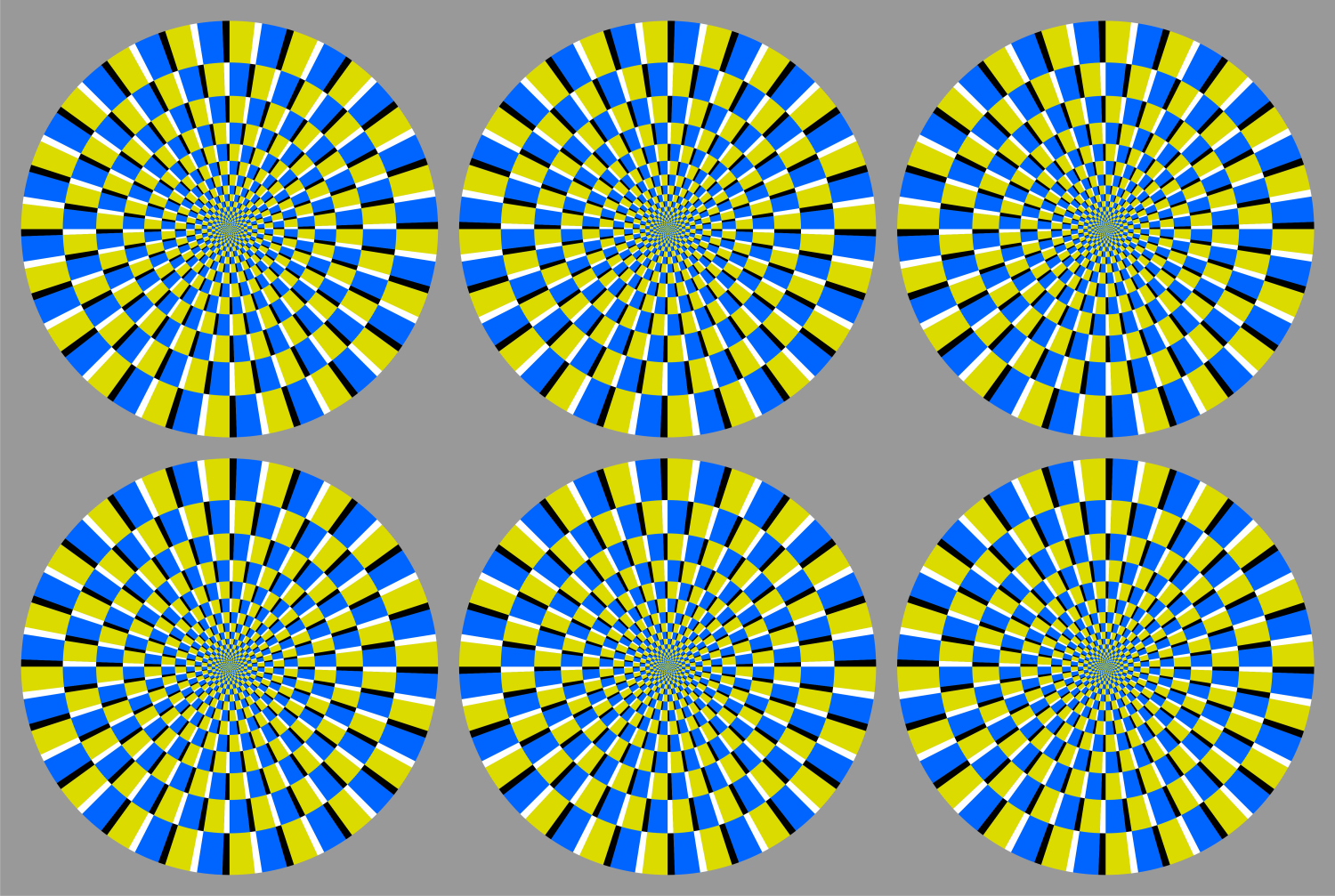
The upper-left, upper-right, and lower-middle disks appear to rotate counterclockwise
while the rest clockwise.
Type IIb
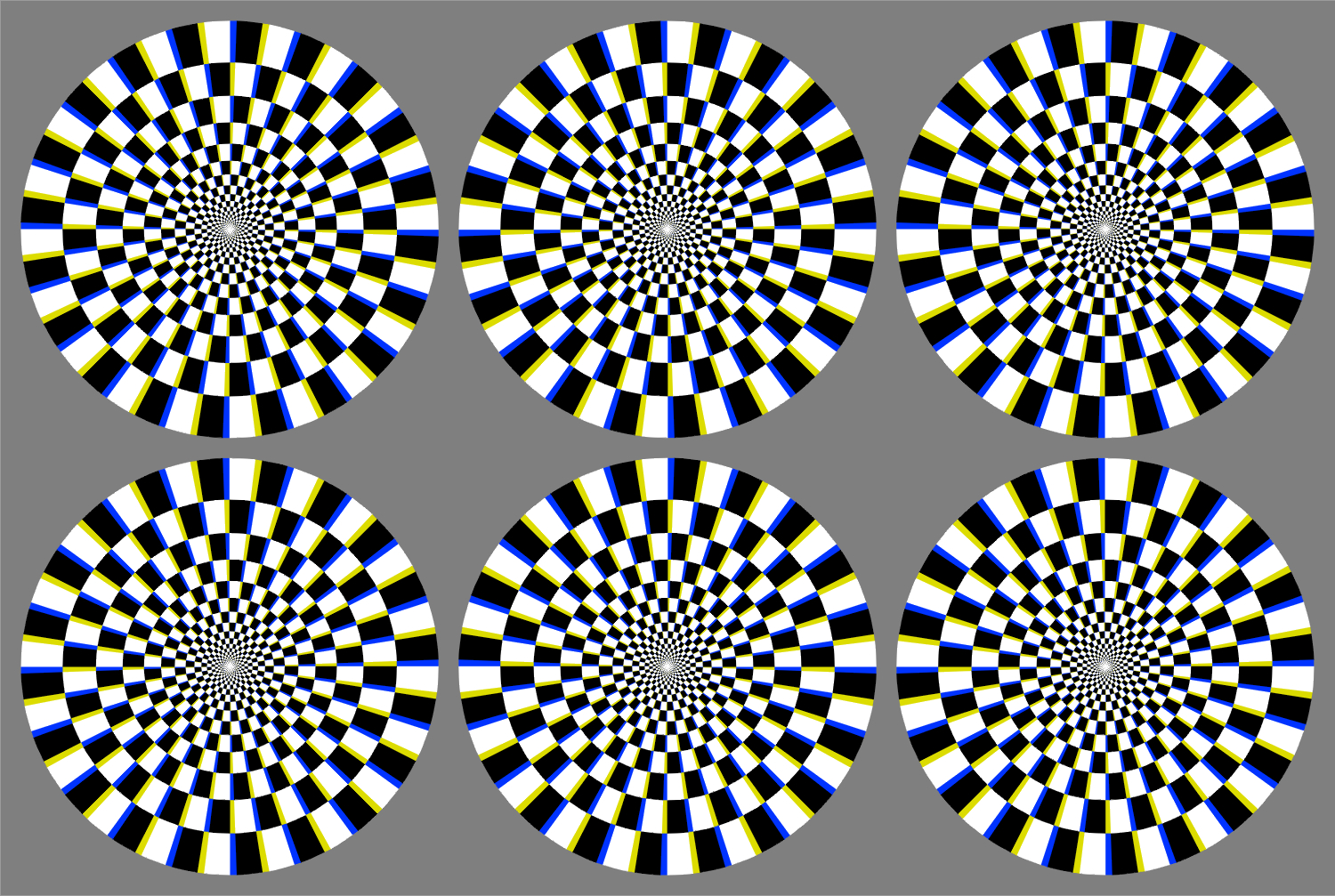
The upper-left, upper-right, and lower-middle disks appear to rotate counterclockwise while the rest clockwise.
Type IIa (six disks) 1500 x 1007 (pixel)
Type IIa (six disks) 6000 x 4031 (pixel)
Type IIb (six disks) 1500 x 1000 (pixel)
Type IIb (six disks) 6000 x 4000 (pixel)
"Rotating snakes"
(Ver. 2011)
Each disk appears to rotate.
Copyright Akiyoshi Kitaoka 2011 (January 23)
Adjusted for printing using EPSON PM-4000PX
Type III

The upper row appears to move rightward while the lower one leftward.
Type III (two rows) 1500 x 400 (pixel)
Type III (two rows) 4500 x 1200 (pixel)Type III 4500 x 1200
.jpg)
The upper-left, upper-right, and lower-middle disks appear to rotate counterclockwise
while the rest clockwise.
6. Kitaoka (2008a, b)
"Type IV" was added to the list.
References
Kitaoka, A. (2008a). Optimized Fraser-Wilcox illusions: a pictorial classification by Akiyoshi Kitaoka. Talk in Workshop No.005 "Experimental studies of anomalous motion illusions" in the 72nd Annual Convention of the Japanese Psychological Association, Hokkaido University, Sapporo, Japan, September 19, 2008. Talk
Kitaoka, A. (2008b). A new type of the optimized Fraser-Wilcox illusion in a 3D-like 2D image with highlight or shade. Journal of Three Dimensional Images (Japan), 22(4), 31-32. PDF PDF (manuscript) Presentation
Type IV
m.jpg)
The upper-left, upper-right, and lower-middle rings appear to rotate counterclockwise
while the rest clockwise.
7. Kitaoka (2008, 2010, 2012a, b)
A strongly color-dependent, "reddish" version was added to the list.
In 2008, Kitaoka found that the direction of illusory motion is “red → dark purple → purple → magenta (light red-purple) → red”, and that the illusion magnitude is strong when overall luminance contrast is low. Images of high luminance make a strong effect.
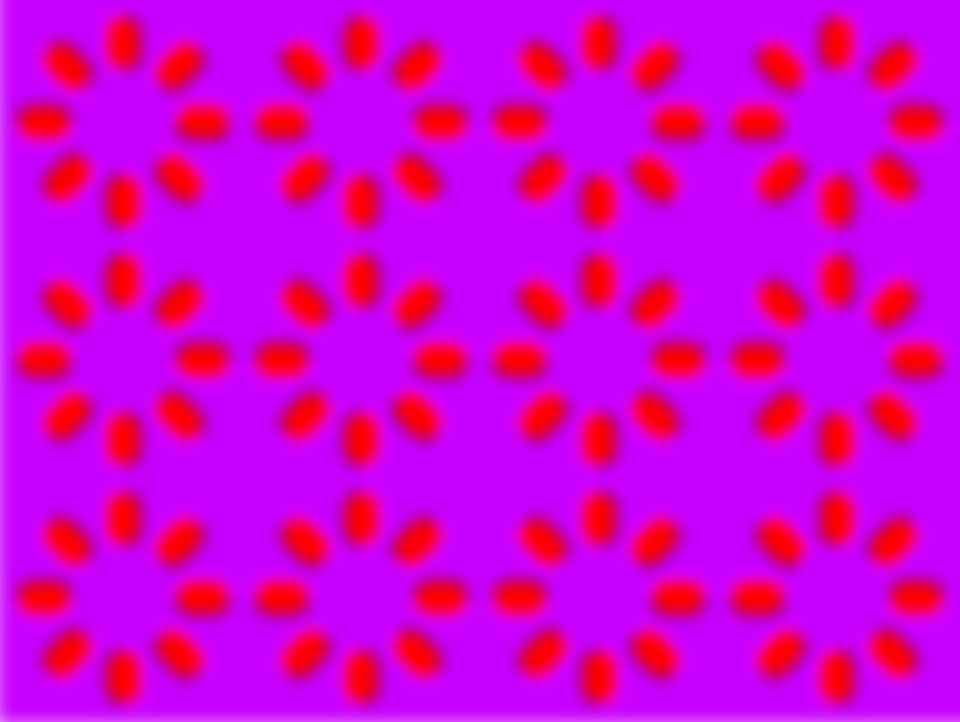
"Rotating red fruits"
Rings of fruits appear to rotate.
Copyright Akiyoshi Kitaoka 2008 (December 19)
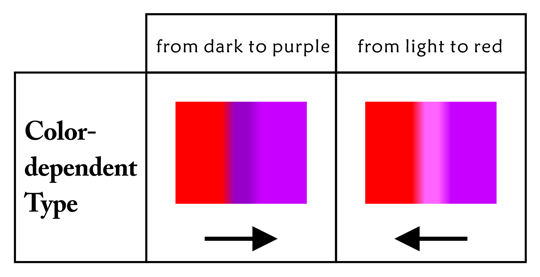
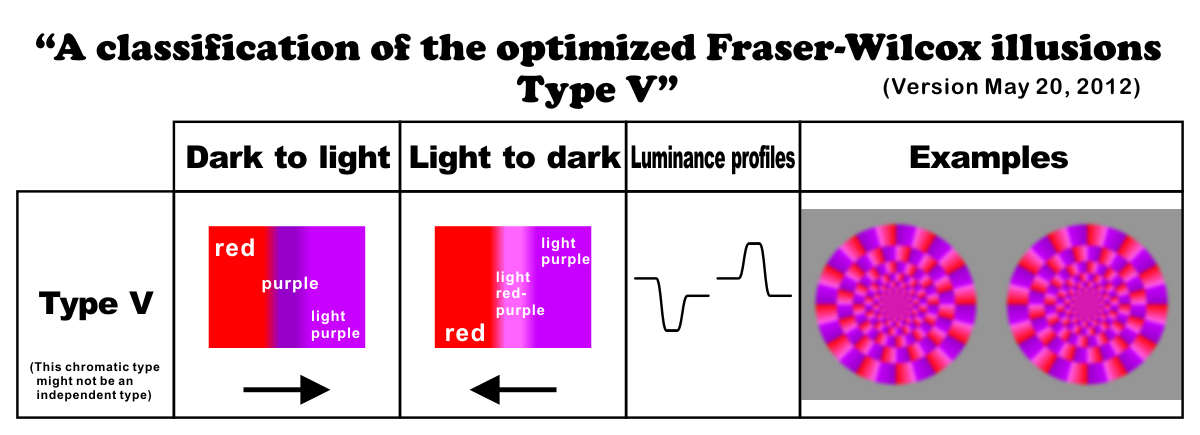
Purple » light purple » light red-purple » red » purple
References
Kitaoka, A. (2010). Introduction to visual illusion. Tokyo: Asakura-shoten (in Japanese). Book
Kitaoka, A. (2012a). Designs using the red Fraser-Wilcox illusion. Journal
of the Color Science Association of Japan, 36, Supplement, 188-189. PDF (color manuscript) Talk
Kitaoka, A. (2012b) The Fraser-Wilcox illusion and its extension. Perception 41 ECVP Abstract Supplement, page 91 (Poster September 3, 2012). Poster PDF
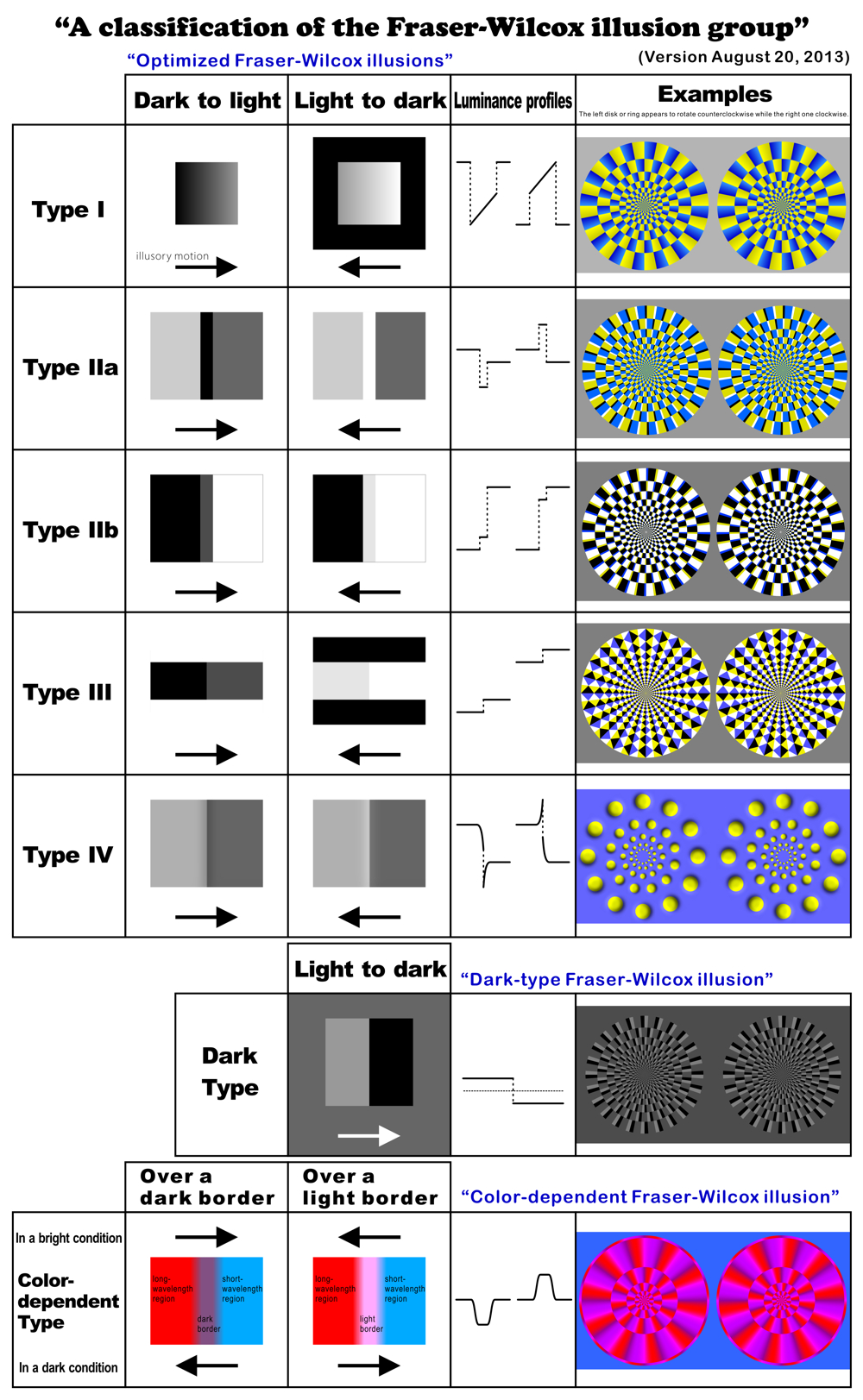
8. Kitaoka (2011)
In 2011, Kitaoka found that flickering the image increases the illusion magnitude. Blinks also work.
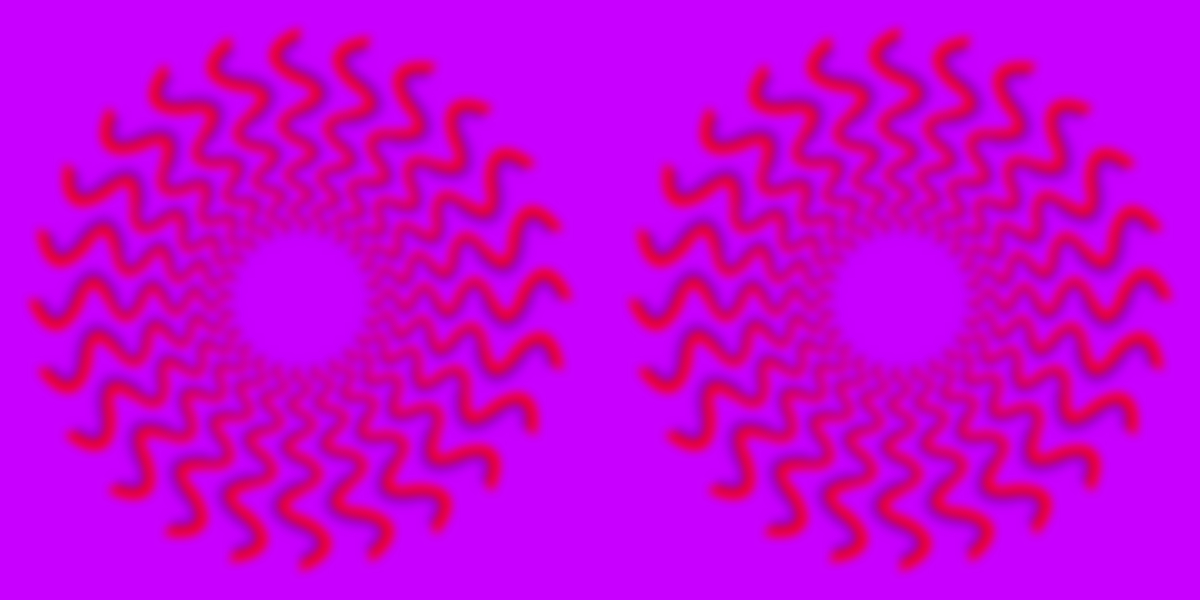
Copyright Akiyoshi Kitaoka 2012 (June 14)
Further studies on the flickering enhancement or induction (Kitaoka, 2013)
Flickering induction depends on the interaction between the stimulus and the blank.
Each disk appears to rotate clockwise during fading-in while counterclockwise during fading-out.
Copyright Akiyoshi Kitaoka 2013 (February 19)
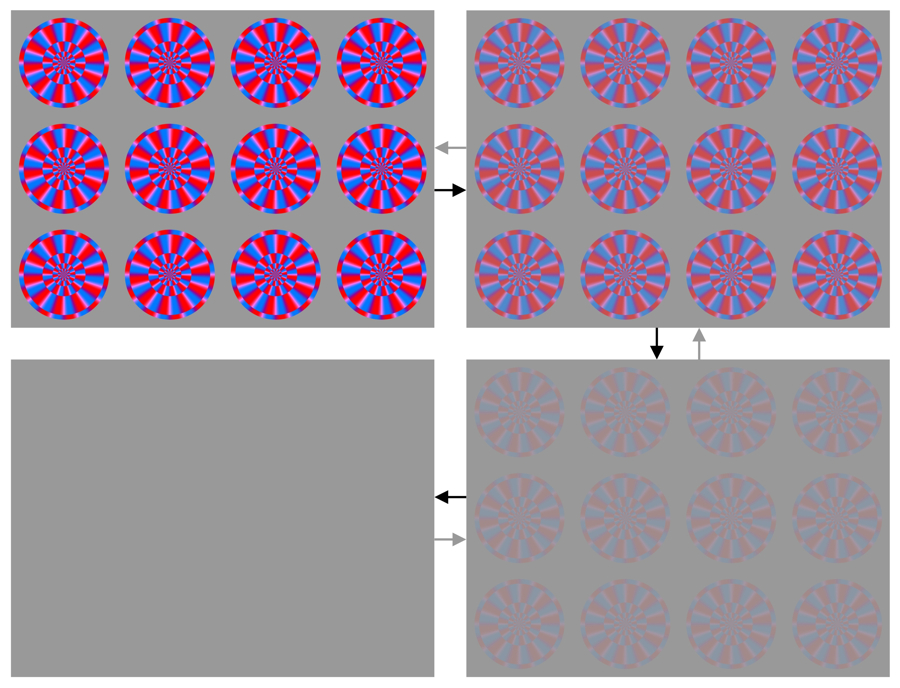
Copyright Akiyoshi Kitaoka 2013 (August 20)
Each disk appears to rotate clockwise during fading-in while counterclockwise during fading-out.
Copyright Akiyoshi Kitaoka 2013 (April 19)
Each disk appears to rotate counteclockwise during fading-in while clockwise during fading-out.
Copyright Akiyoshi Kitaoka 2013 (April 19)
Each disk appears to rotate counteclockwise during fading-in while clockwise during fading-out.
Copyright Akiyoshi Kitaoka 2013 (April 19)
Each disk appears to expand during fading-in while to contract during fading-out.
Copyright Akiyoshi Kitaoka 2013 (April 20)
9. Yanaka and Hirano (2011)
Yanaka and Hilano (2011) reported that this illusion is enhanced by mechanical shaking.
Each disk appears to rotate counterclockwise.
(Note that this movie is not their original)
References
Yanaka, K. and Hilano, T. (2011). Mechanical shaking system to enhance
"Optimized Fraser–Wilcox Illusion Type V". Perception, 40, ECVP
Abstract Supplement, page 171.
10. Yanaka (2012)
Yanaka (2012) reported that this illusion is enhanced by viewing images under dark illumination.
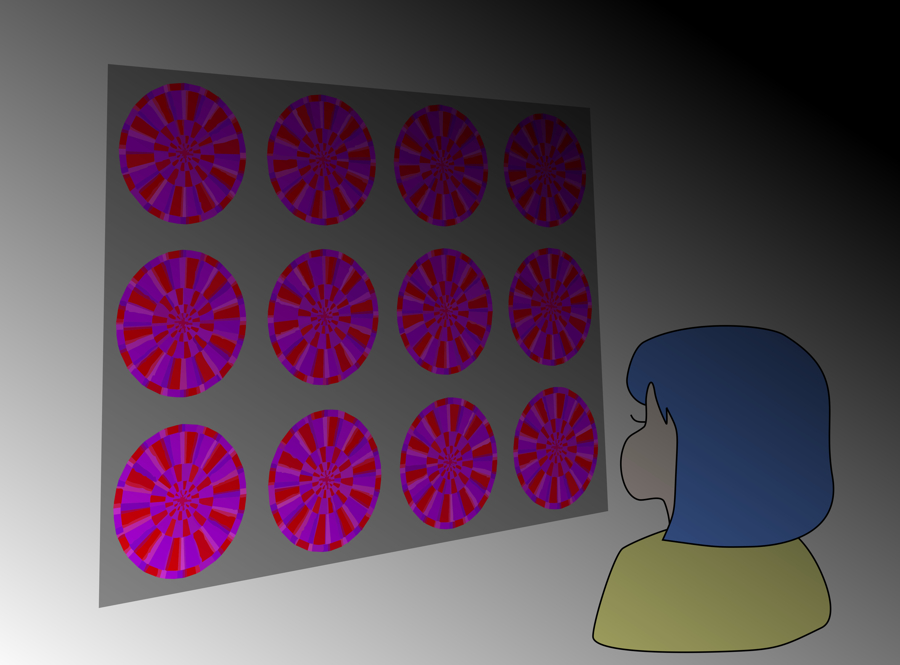
References
Yanaka, K. (2012). Enhancement of the optimized Fraser-Wilcox illusion Type V by swinging the image. Talk in the 5th Illusion Workshop, Meiji University, Tokyo, Japan, September 18, 2012.
11. Kitaoka (2013)
In 2013, Kitaoka (ECVP2013) found that Yanaka’s darkening enhancement is accompanied by a reversal of illusion: i.e., the direction under dark condition is “red → magenta (light red-purple) → purple → dark purple → red”.
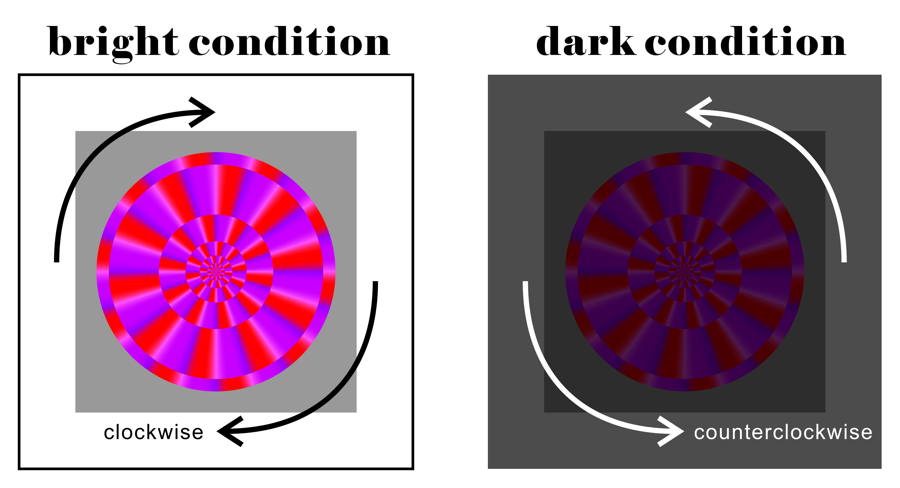
References
Kitaoka, A. (2013). Invisible color and visible color: Mystery of color the brain feels. Talk in the Shizuoka Science Museum Ru-Ku-Ru, Shizuoka, Japan, January 13, 2013. Talk
12. Kitaoka (2013)
In 2013, Kitaoka (ECVP2013) found that combination of a long wavelength color and a short one makes the illusions.
Illusory motion depending on the combination of colors


"Rotating red-and-purple disks"
Each disk appears to rotate clockwise on a bright display, while it appears to rotate counterclockwise with a printed image under dark illumination.
Copyright Akiyoshi Kitaoka 2013 (February 6)
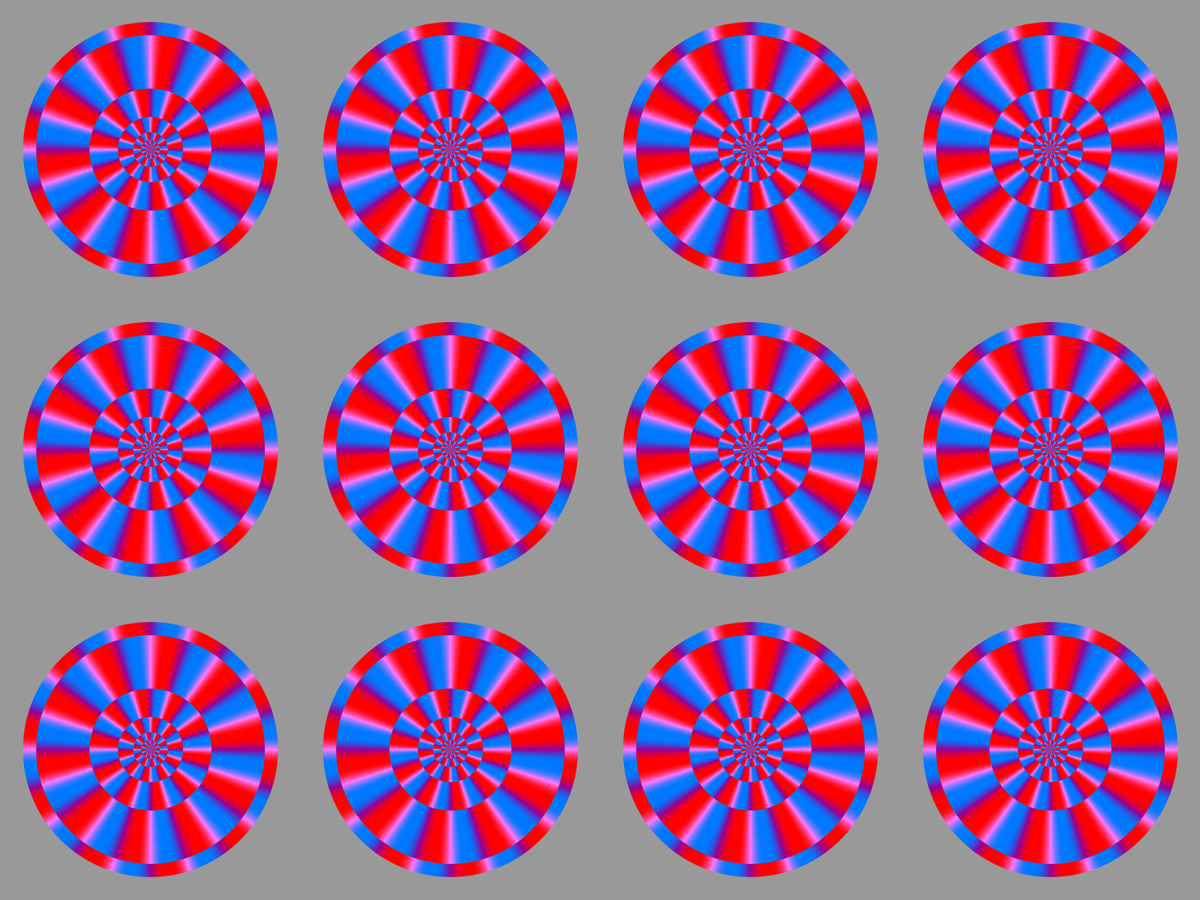
"Rotating red-and-cyan disks"
Each disk appears to rotate clockwise on a bright display, while it appears to rotate counterclockwise with a printed image under dark illumination.
Copyright Akiyoshi Kitaoka 2013 (February 1)

"Rotating red-and-cyan disks 2"
Each disk appears to rotate clockwise on a bright display, while it appears to rotate counterclockwise with a printed image under dark illumination.
Copyright Akiyoshi Kitaoka 2013 (February 6)
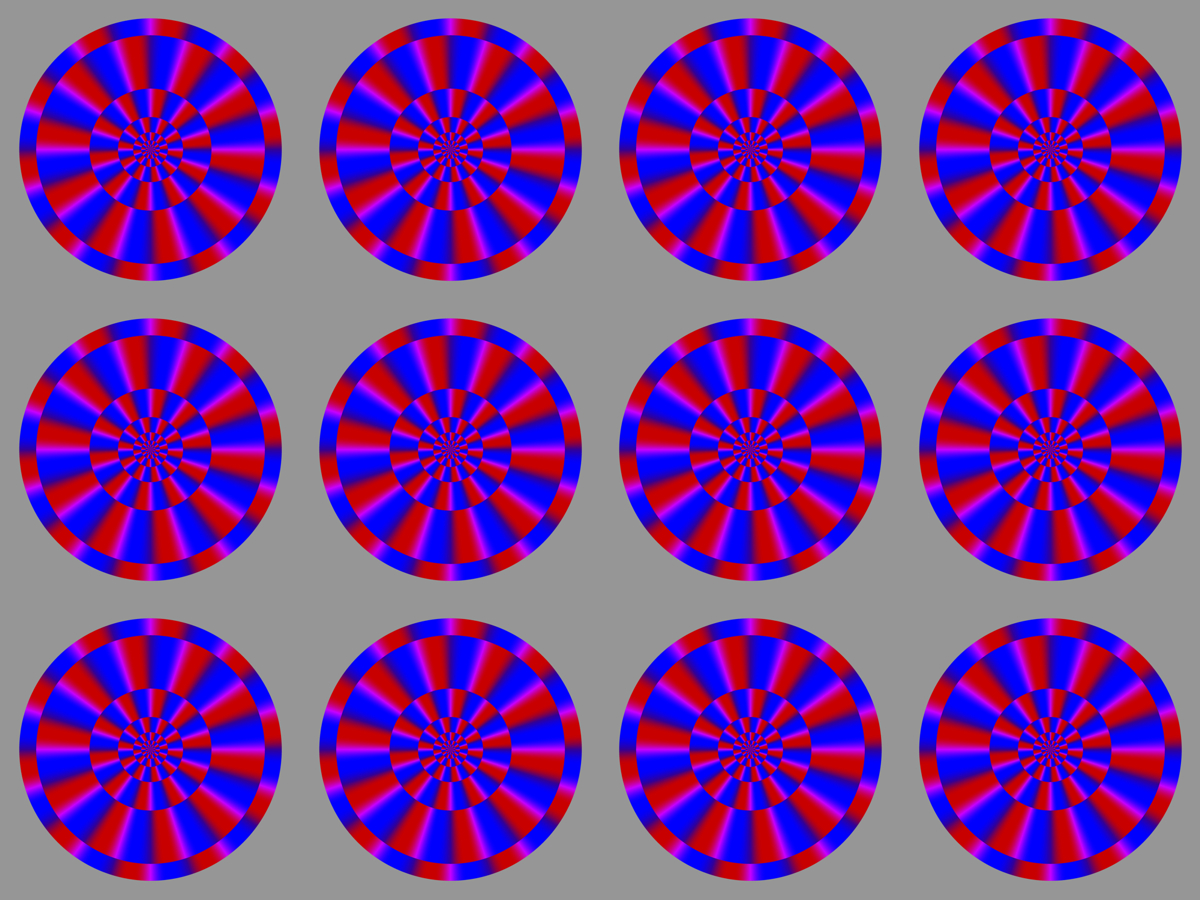
"Rotating red-and-blue disks"
Each disk appears to rotate clockwise on a bright display, while it appears to rotate counterclockwise with a printed image under dark illumination.
Copyright Akiyoshi Kitaoka 2013 (January 29)
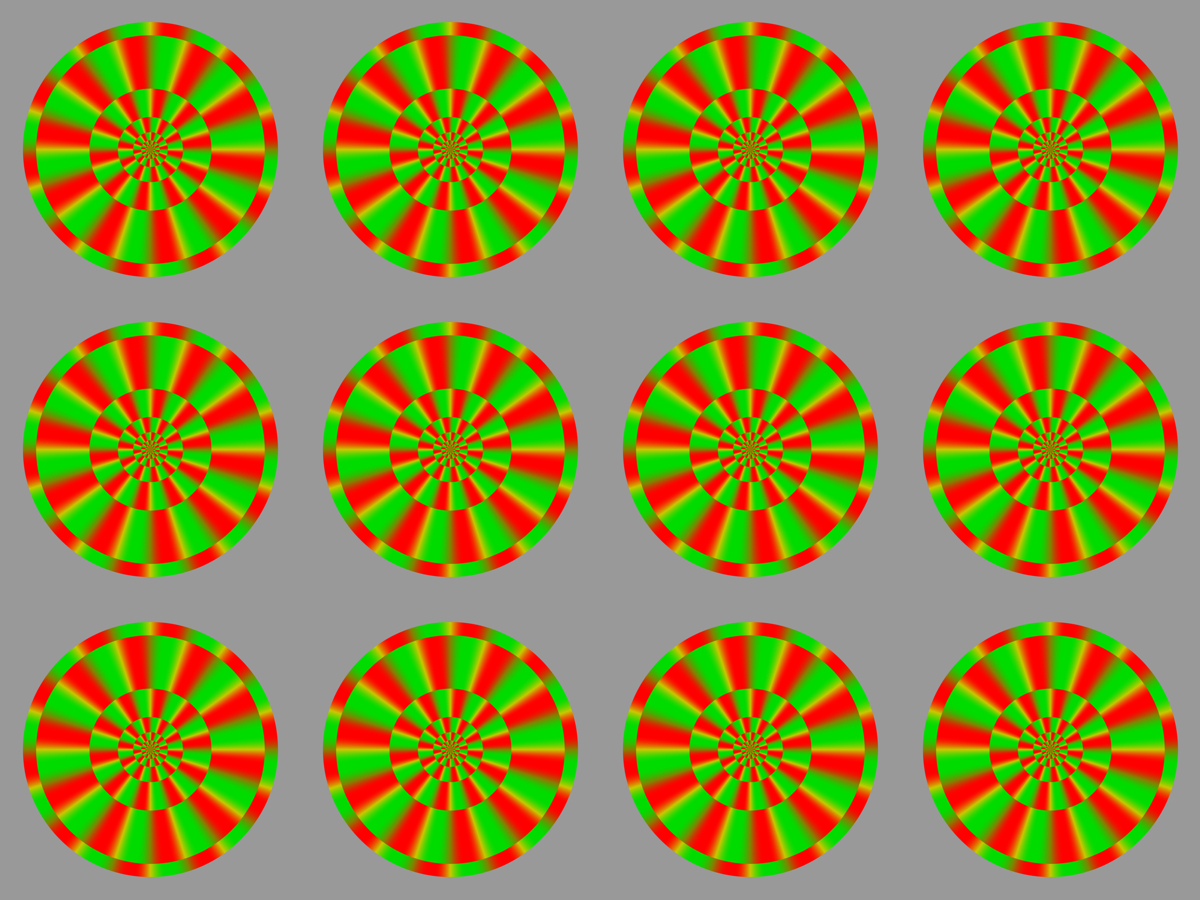
"Rotating red-and-green disks"
Each disk appears to rotate clockwise on a bright display, while it appears to rotate counterclockwise with a printed image under dark illumination.
Copyright Akiyoshi Kitaoka 2013 (January 29)
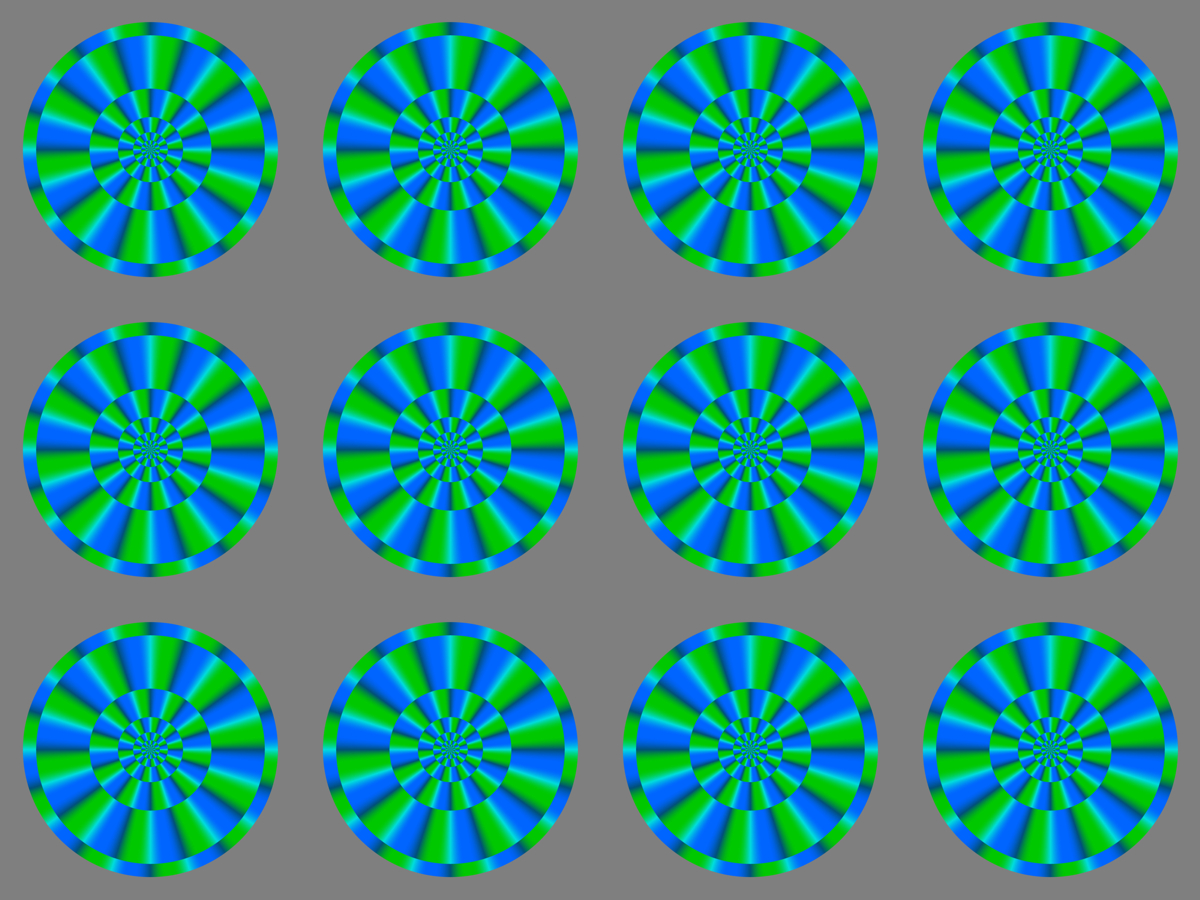
"Rotating blue-and-green disks"
Each disk appears to rotate clockwise on a bright display, while it slightly appears to rotate counterclockwise with a printed image under dark illumination.
Copyright Akiyoshi Kitaoka 2013 (February 6)
13. Kitaoka (2013)
In 2013, Kitaoka (ECVP2013) found that increasing or decreasing illumination makes the illusions.
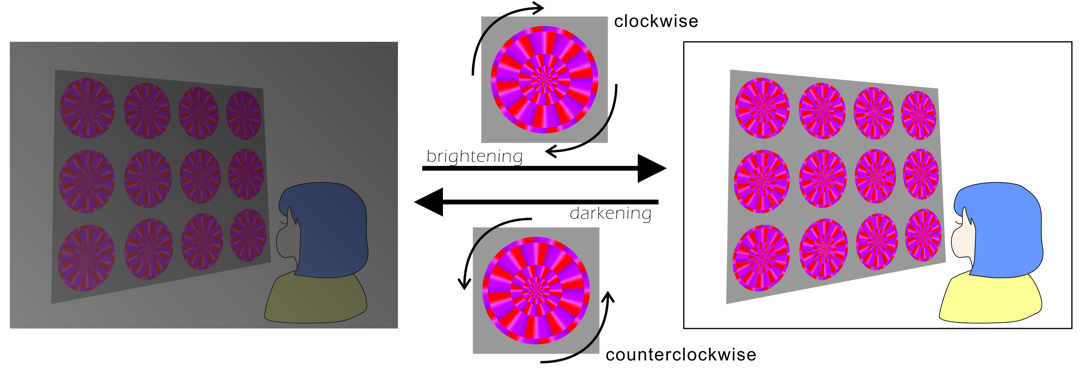
14. Kitaoka (2013)
It is suggested that this ‘luminance change-induced’ motion* might generate
the color-dependent Fraser-Wilcox illusion, being triggered by saccades,
blinks, flickering or shaking the images.
*The luminance change-induced’ motion includes the reverse phi phenomenon
(Anstis, 1970; Anstis and Rogers, 1975) and the phenomenal phenomena (Gregory
and Heard, 1983). Directions of illusory motion depending on the changes
of luminance are shown in the right (Kitaoka, 2006).
References
Anstis S M, 1970 “Phi movement as a subtraction process” Vision Research 10 1411-1430
Anstis S M, Rogers B J, 1975 “Illusory reversal of visual depth and movement
during changes of contrast” Vision Research 15 957-961
Gregory R L, Heard P F, 1983 “Visual dissociations of movement, position,
and stereo depth: some phenomenal phenomena” Quarterly Journal of Experimental
Psychology 35A 217-237
Kitaoka, A. (2006). Configurational coincidence among six phenomena: A
comment on van Lier and Csathó (2006). Perception,
35, 799-806. animations --- PDF
"Rotating gray-scale disks (movie)"
Disks appear to rotate clockwise or counterclockwise.
Copyright Akiyoshi Kitaoka 2013 (February 15)
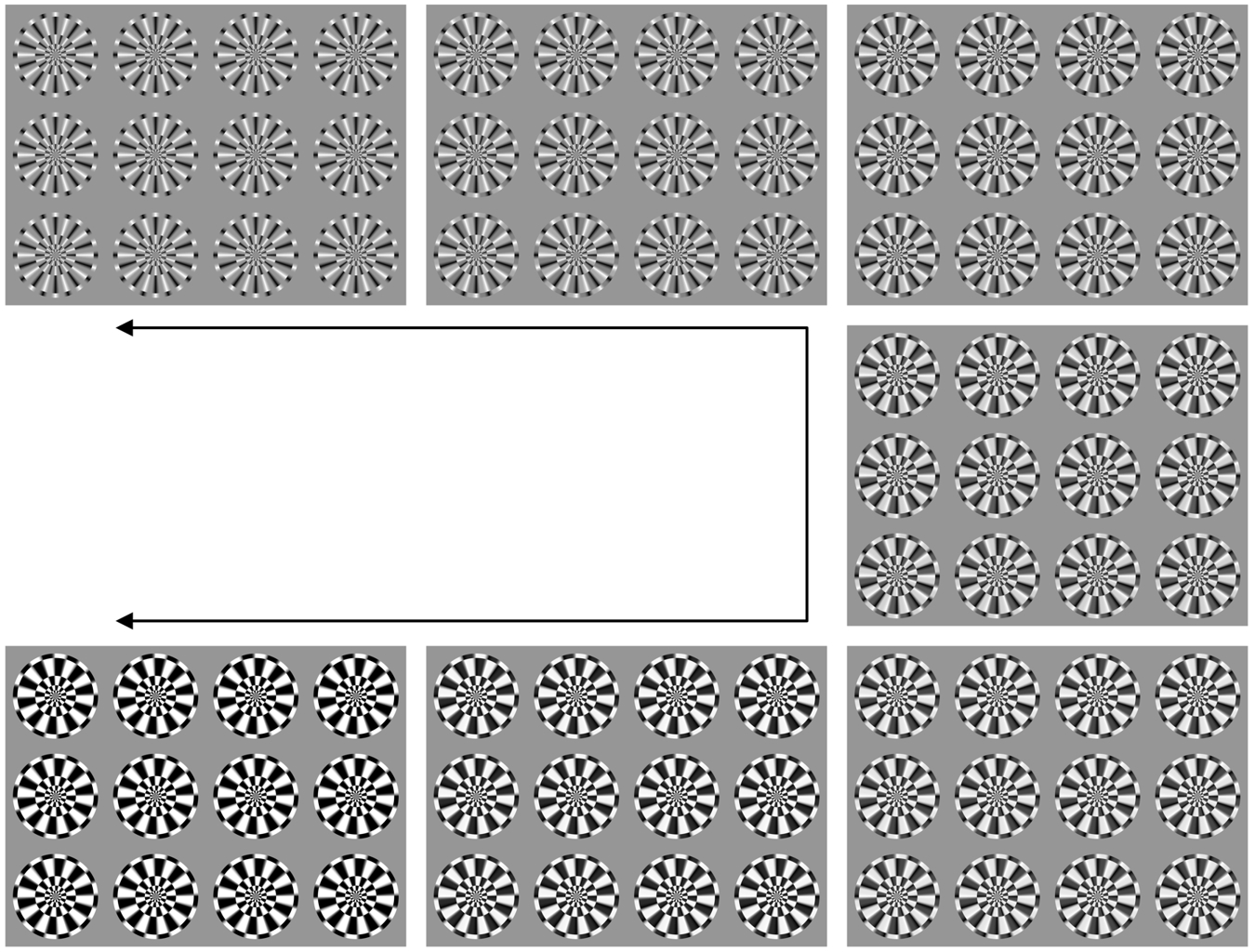
Configurational coincidence among six phenomena: A comment to van Lier
and Csathó (2006)
Kitaoka, A. (2006). Configurational coincidence among six phenomena: A comment on van Lier and Csathó (2006). Perception, 35, 799-806. animations --- PDF
Adobe Flash Player is necessary to play animations on this page.
Animation 1
Reversed phi movement (Anstis and Rogers 1975). There are four rectangles, each of which is flanked by thin lines that are dark or light. When the luminance of the rectangles decreases and that of the background increases accordingly, the upper two appear to converge in motion while the lower two appear to go apart in motion. On the other hand, when the luminance of the rectangles increases and that of the background decreases accordingly, the upper two appear to go apart in motion while the lower two appear to approach each other in motion. In sum, the direction of apparent motion is from the dark flank to the neighboring part that goes darkening or from the light flank to the neighboring part that goes brightening. Although the rectangles are aligned vertically, the apparent positional displacement occurs in the opposite direction to motion. If observers cross-fuse (uncross-fuse) the right and left rectangles, the upper rectangle appears to be in front of (behind) the lower one when they are dark.
Animation 2
The illusory motion investigated by Gregory and Heard (1983). This appearance is quite similar to Animation 1. The only configurational difference from the reversed phi movement is that the luminance of the rectangles is constant.
Animation 3
The illusory motion mentioned by Gregory and Heard (1983), in which the luminance of the rectangles dynamically changes while that of the surround is constant. This appearance is quite similar to Animations 1 and 2.
Animation 4
Phi movement (Anstis and Rogers 1975). For panel (a), dark stationary rectangles are placed on a bright stationary background. When the luminance of the right flank of each rectangle increases and that of the left flank decreases, the rectangle appears to shift leftward in motion as well as in position. Conversely, the luminance of the right flank decreases and that of the left flank increases, the rectangle appears to shift rightward in motion and position. If observers cross-fuse (uncross-fuse) the right and left rectangles, the fused rectangle appears to be in front (behind) when the right flank of the right rectangle are dark and the left flank of the left rectangle are dark. For panel (b), bright rectangles are placed on a dark background. In this case, phenomena are the reversal of panel (a).
(a) (b)
(a) Flash(swf) --- QuickTime(mov)
(b) Flash(swf) --- QuickTime(mov)
Animation 5
Consistency between the reversed phi movement and stereopsis (Anstis and Rogers 1975). In this animation, there are two phases in motion, in which the upper-left and the lower-right rectangles are one eighth phase in advance of the upper-right and the lower-left rectangles. For example, when the luminance of the rectangles increases, the upper-left rectangle appear to go leftward followed by the upper-right one, while the lower-right rectangle appear to go leftward followed by the lower-left one. In this period, the cross-fused (uncross-fused) upper rectangle appears to be in front (behind) as compared with the cross-fused (uncross-fused) lower rectangle.
Animation 6
Consistency between the apparent motion and Café-Wall-like tilt illusions (van Lier and Csathó 2005). According to dynamic changes in luminance gradient, the flanks of the rectangle appears to tilt dynamically. (a) The luminance gradient given to both flanks is dynamically changed while the dark-gray rectangle and the light-gray background are stationary. The dark part of the gradient appears to shift outward in motion and position while the bright part appears to shift inward in motion and position. This distortion agrees with the tilt illusion. (b) The luminance gradient given to the rectangle is dynamically changed while the dark flanks and the gray background are stationary. At the dark part of the gradient, the neighboring part of flanks appears to shift inward in motion and position, while at the bright part of the gradient, the neighboring part of flanks appears to shift outward in motion and position. This distortion agrees with the tilt illusion.
(a) (b)
(a) Flash(swf) --- QuickTime(mov)
(b) Flash(swf) --- QuickTime(mov)
Animation 7
Inconsistency between the apparent motion and Café-Wall-like tilt illusions. According to dynamic changes in homogenous areas, the flanks of the rectangle appears to tilt dynamically. (a) The luminance of the homogeneous rectangle is dynamically changed while the flanks with luminance gradient and the gray background are stationary. The darkening rectangle appears to attract the dark parts of the flanks inward in motion while the brightening rectangles appears to attract the light parts of the flanks inward in motion. This distortion disagrees with the tilt illusion. (b) The luminance of the homogeneous flanks is dynamically changed while the rectangle with luminance gradient and the gray background are stationary. At the dark part of the gradient, brightening flanks appears to shift inward in motion, while at the bright part of the gradient, darkening flanks appears to shift inward in motion. This distortion disagrees with the tilt illusion
(a) (b)
(a) Flash(swf) --- QuickTime(mov)
(b) Flash(swf) --- QuickTime(mov)
Animation 8
Demonstration of the apparent motion in the three elemental spatio-temporal configurations (Figure 6). The behaviors in (a), (b) and (g) are summarized in Figure 6a (off-center line-type configuration); those in (c), (d) and (h) are in Figure 6b (on-center line-type configuration); and those in (e), (f) and (i) are summarized in Figure 6c (edge-type configuration). For further explanations, see the text.
(a) (b)
(a) Flash(swf) --- Quicklime(mov)
(b) Flash(swf) --- QuickTime(mov)
(c) (d)
(c) Flash(swf) --- QuickTime(mov)
(d) Flash(swf) --- QuickTime(mov)
(e) (f)
(e) Flash(swf) --- QuickTime(mov)
(f) Flash(swf) --- QuickTime(mov)
(g) (h) (i)
(g) Flash(swf) --- QuickTime(mov)
(h) Flash(swf) --- QuickTime(mov)
(i) Flash(swf) --- QuickTime(mov)
Directions of illusory motion depending on changes of luminance in each
area
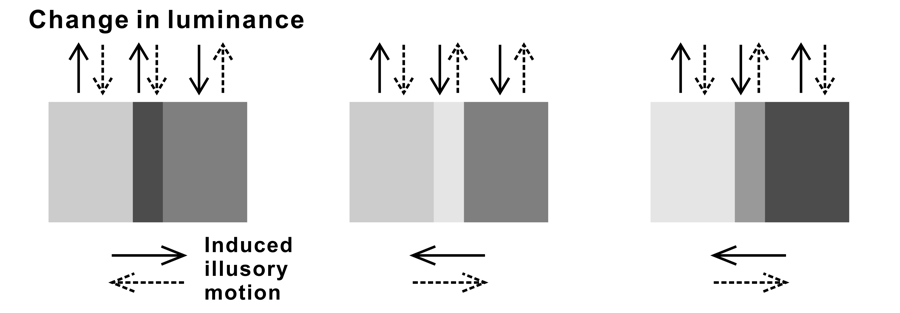

Involvement of the Purkinje shift is suggested. Short wavelength color
appears to be relatively bright under a dark condition. Decreasing illumination
makes short wavelength color relatively bright. This might induce the luminance
change-dependent motion illusion and show the color-dependent Fraser-Wilcox
illusion.
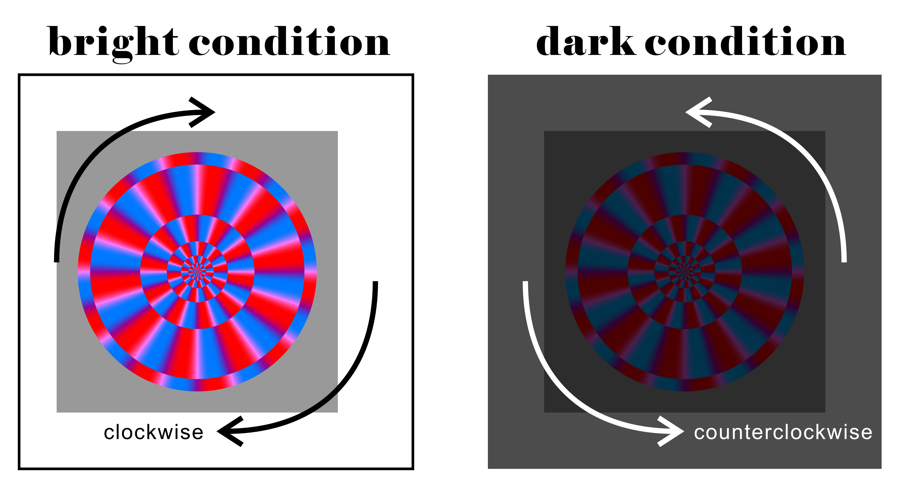
Conclusion: It is suggested that the color-dependent Fraser-Wilcox illusion be attributed to the luminance change-dependent motion illusion through the Purkinje effect, being triggered by saccades, blinks, flickering or shaking the images.

生理学研究所研究会
「視知覚の現象・機能・メカニズム - 生理学的、心理物理学的、計算論的アプローチ」
日 時:平成25年9月12日(木)13時00分~18時05分(終了後に懇親会)
9月13日(金)9時00分~12時55分
場 所:自然科学研究機構 岡崎コンファレンスセンター 中会議室
代 表:村上郁也(東京大学大学院人文社会系研究科)
世話人:小松英彦(生理学研究所感覚認知情報研究部門)
交 通:会場の場所は生理研ホームページ(http://www.nips.ac.jp/)の交通案内をご覧下さい。
2013年9月12日(木)
13時00分~13時05分 挨拶
セッション1
13時05分~13時40分「弱視の症状理解と援助法の開発 心理物理学的アプローチ」
前原吾朗(神奈川大学 人間科学部)
13時40分~14時15分 「LIP野ニューロンにおける感覚情報の蓄積スピードは課題によって変化する」
宇賀貴紀(順天堂大学 大学院医学研究科)
14時15分~14時50分 「局所運動信号の関係性についての視覚処理過程」
丸谷和史(NTT コミュニケーション科学基礎研究所)
14時50分~15時25分 「サルMT野における奥行き運動(Motion-in-depth)選択性とそのメカニズム」
眞田尚久(生理学研究所 感覚認知情報研究部門)
15時25分~15時45分 コーヒーブレイク
セッション2
15時45分~16時20分 「視覚的顕著性の計算モデルの高度化と視線推定への応用」
佐藤洋一(東京大学生産技術研究所)
16時20分~16時55分 「色依存性の静止画が動いて見える錯視」
北岡明佳(立命館大学 文学部)
16時55分~17時30分 「中心暗点を有する眼疾患患者の第一次視覚野反応」
増田洋一郎(東京慈恵会医科大学 眼科学講座)
17時30分~18時05分「サル大脳皮質V1野およびV4野の機能構築:2光子カルシウムイメージング法 による解析」
藤田一郎(大阪大学 大学院生命機能研究科)
18時30分 懇親会(岡崎コンファレンスセンター)
2013年9月13日(金)
セッション3
9時00分~9時35分「大脳皮質MT/MST野の活動は動く視覚刺激のフーリエ成分に依存する」
三浦健一郎(京都大学 大学院医学研究科)
9時35分~10時10分「聴覚随伴性視覚運動知覚の諸相」
寺本 渉(室蘭工業大学 情報電子工学系学科)
10時10分~10時45分「方位カラム形成再考:視体験効果、臨界期、種差」
田中 繁(電気通信大学 電気通信学部)
10時45分~11時05分 コーヒーブレイク
セッション4
11時05分~11時40分「尾状核尾部における情報統合と感覚運動変換」
山本慎也(産業技術総合研究所 ヒューマンライフテクノロジー研究部門)
11時40分~12時15分「知覚と運動における学習の干渉と固定化」
四本裕子(東京大学 大学院総合文化研究科)
12時15分~12時50分「初期視覚系の刺激文脈依存的反応修飾」
佐藤宏道(大阪大学 大学院医学系研究科)
12時50分~12時55分 挨拶